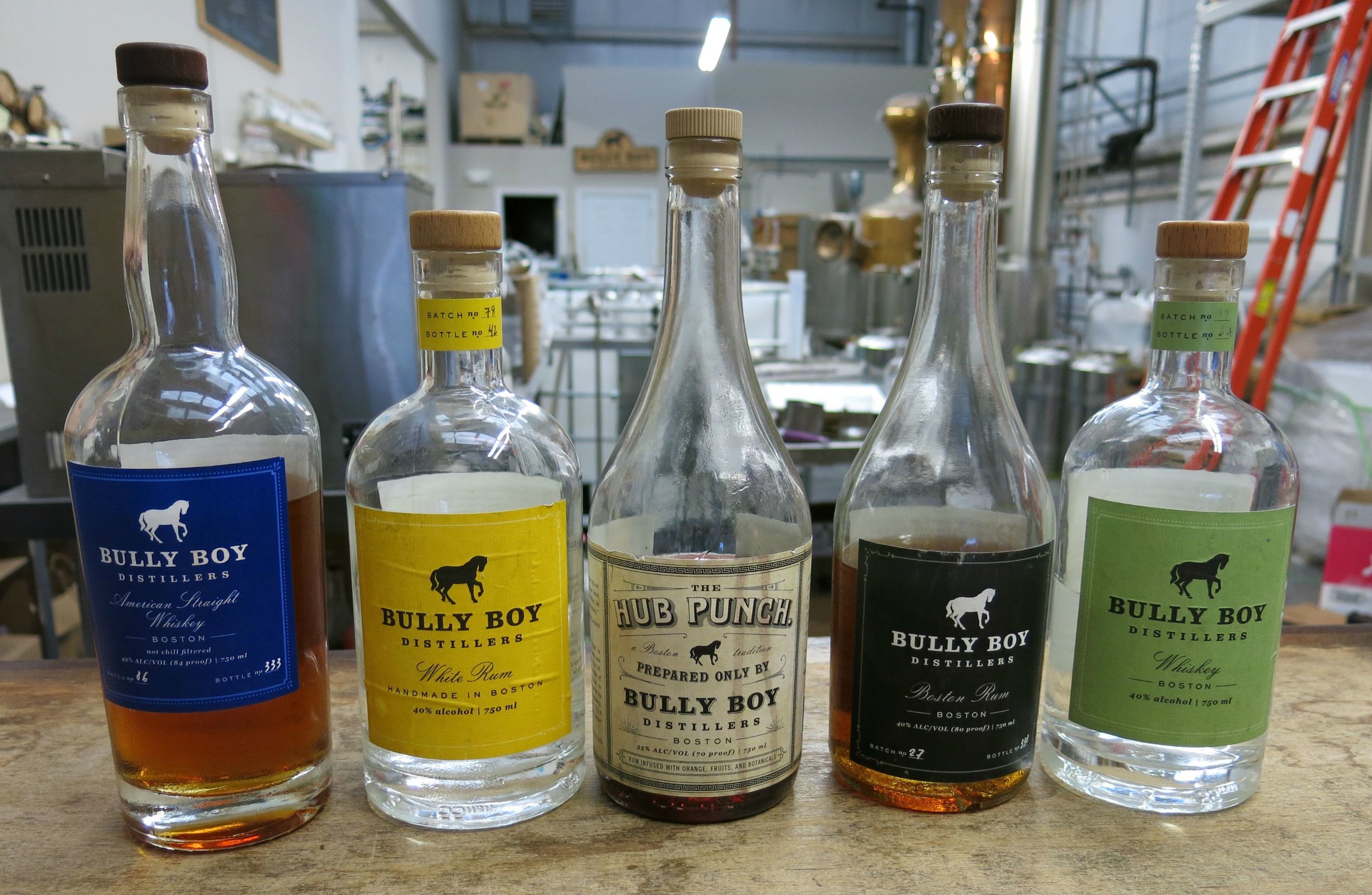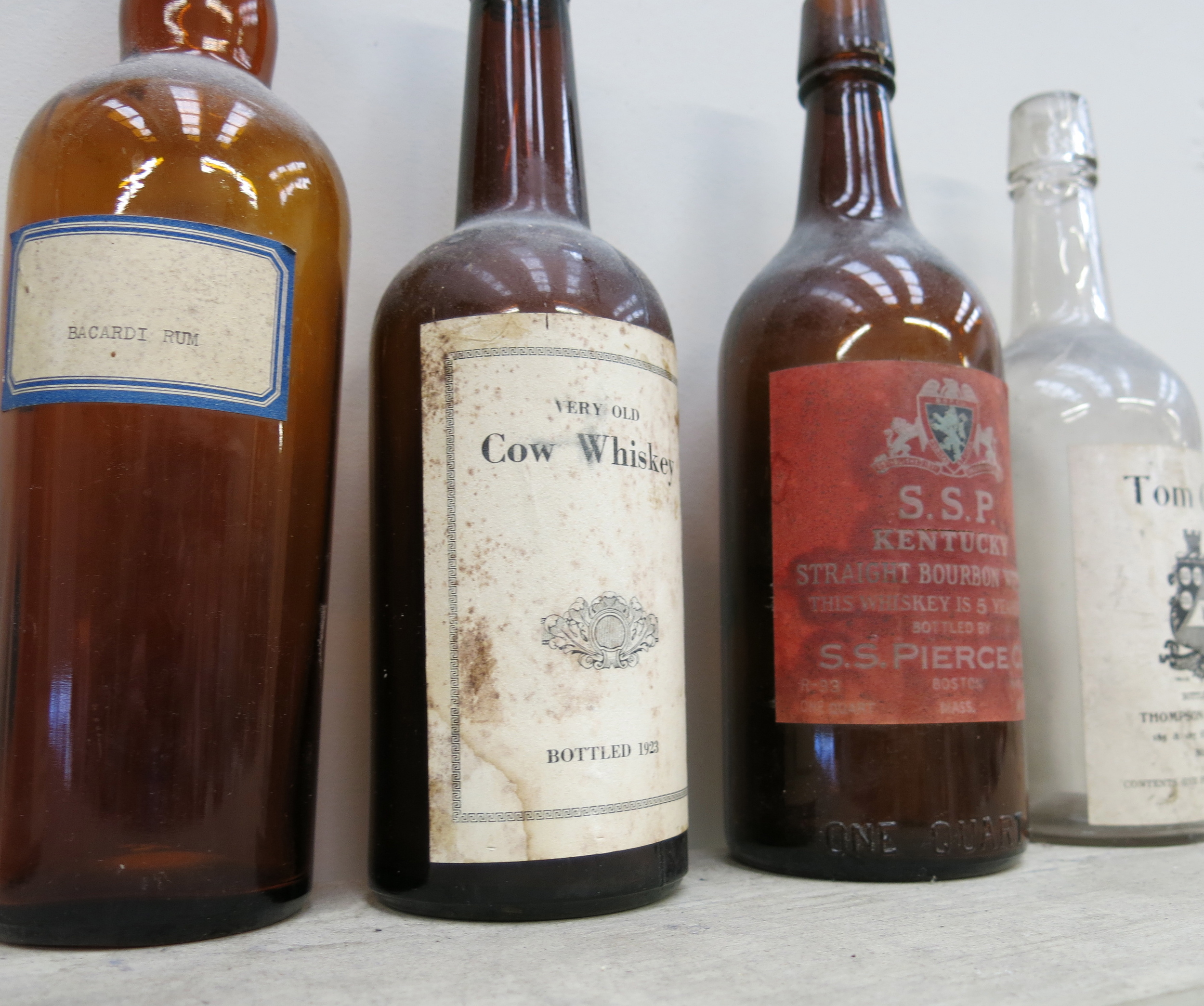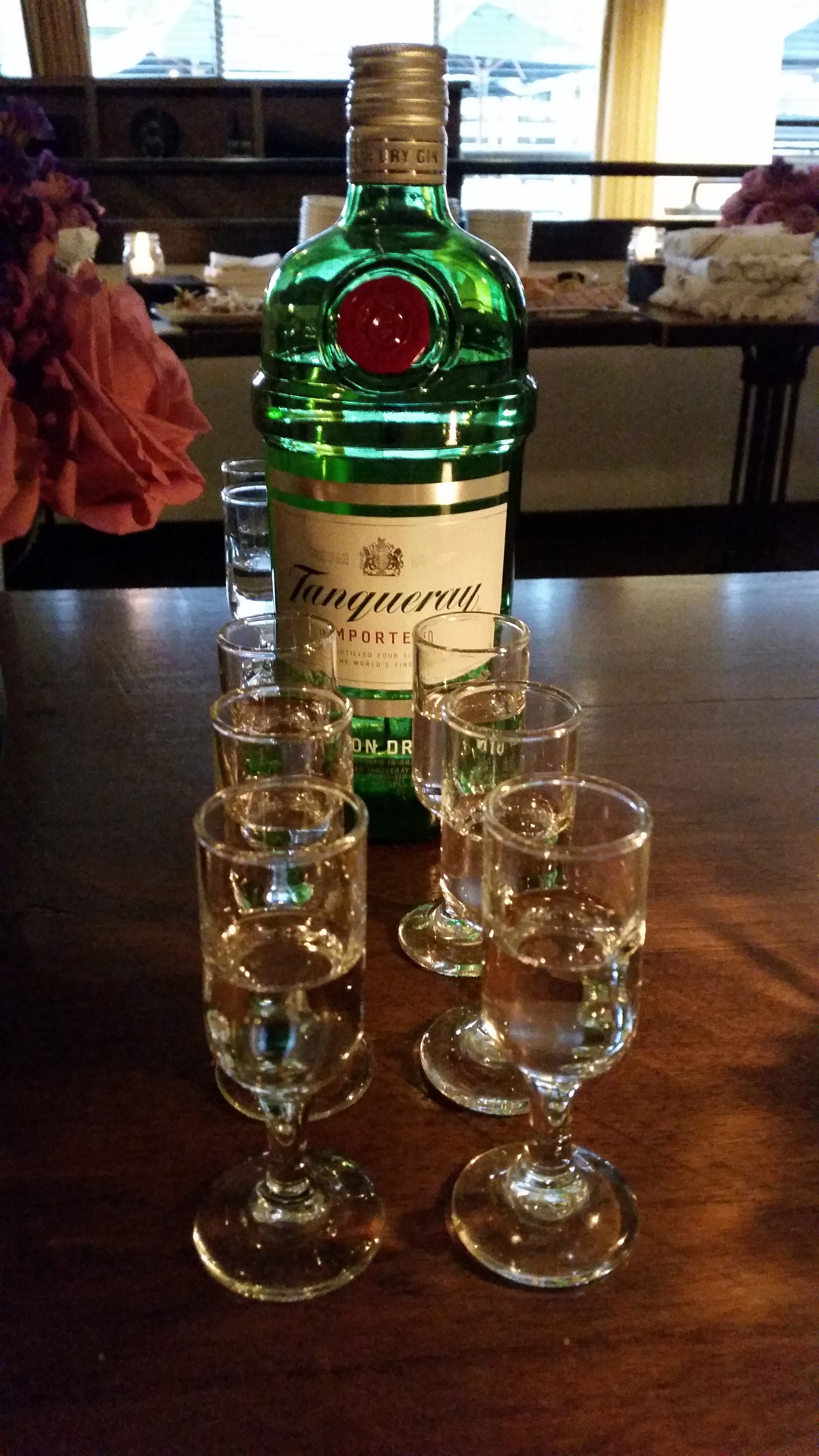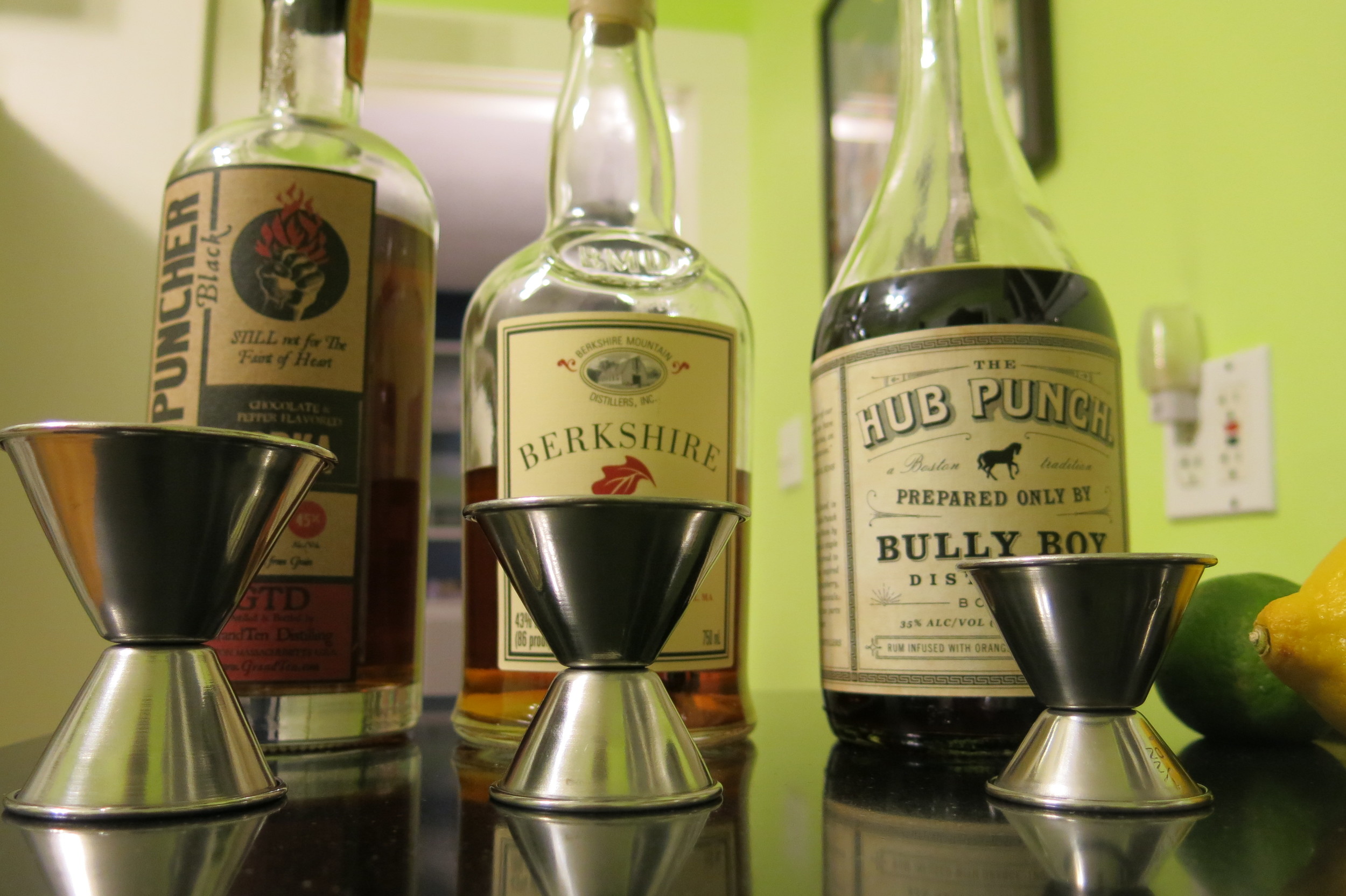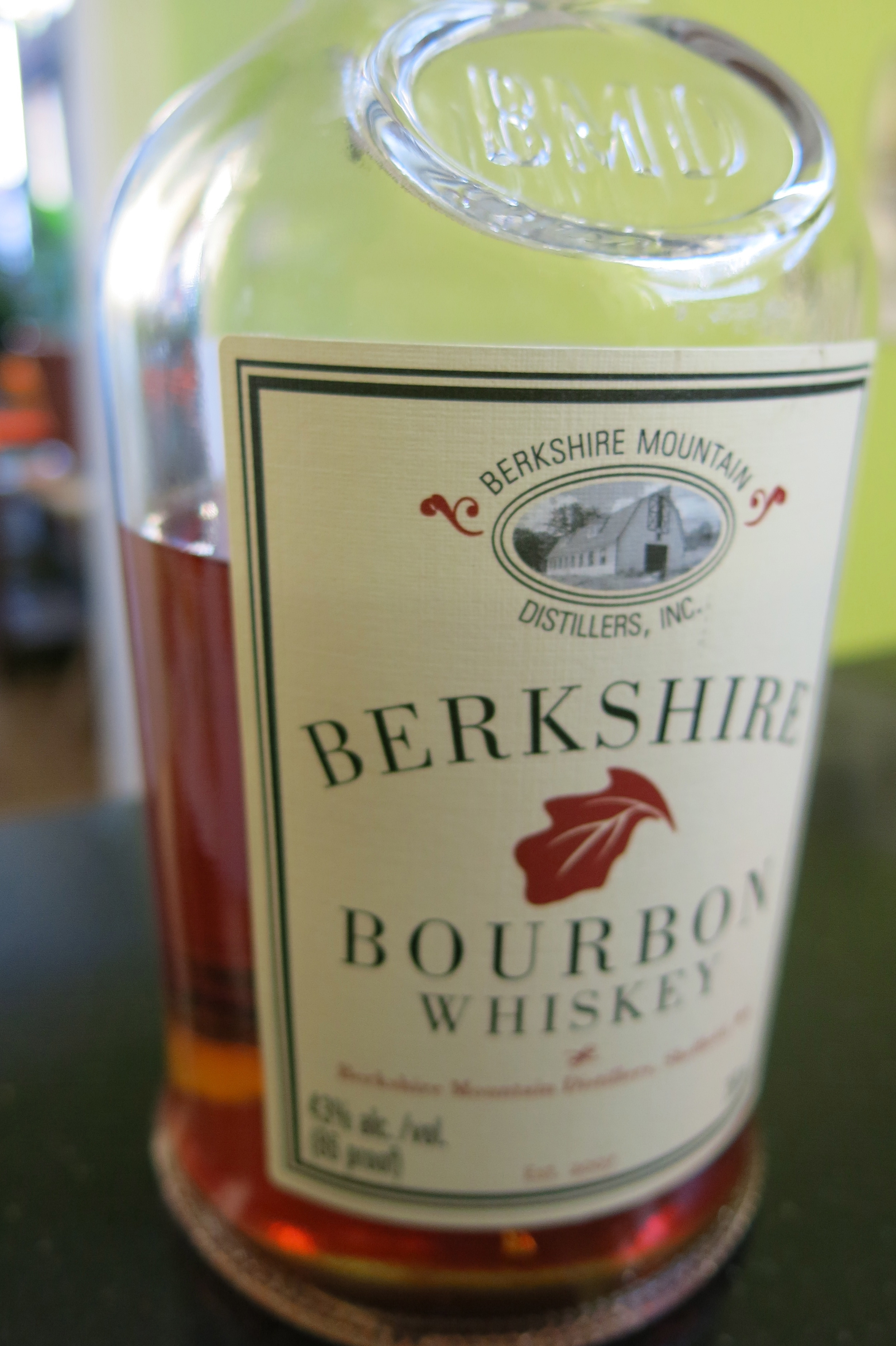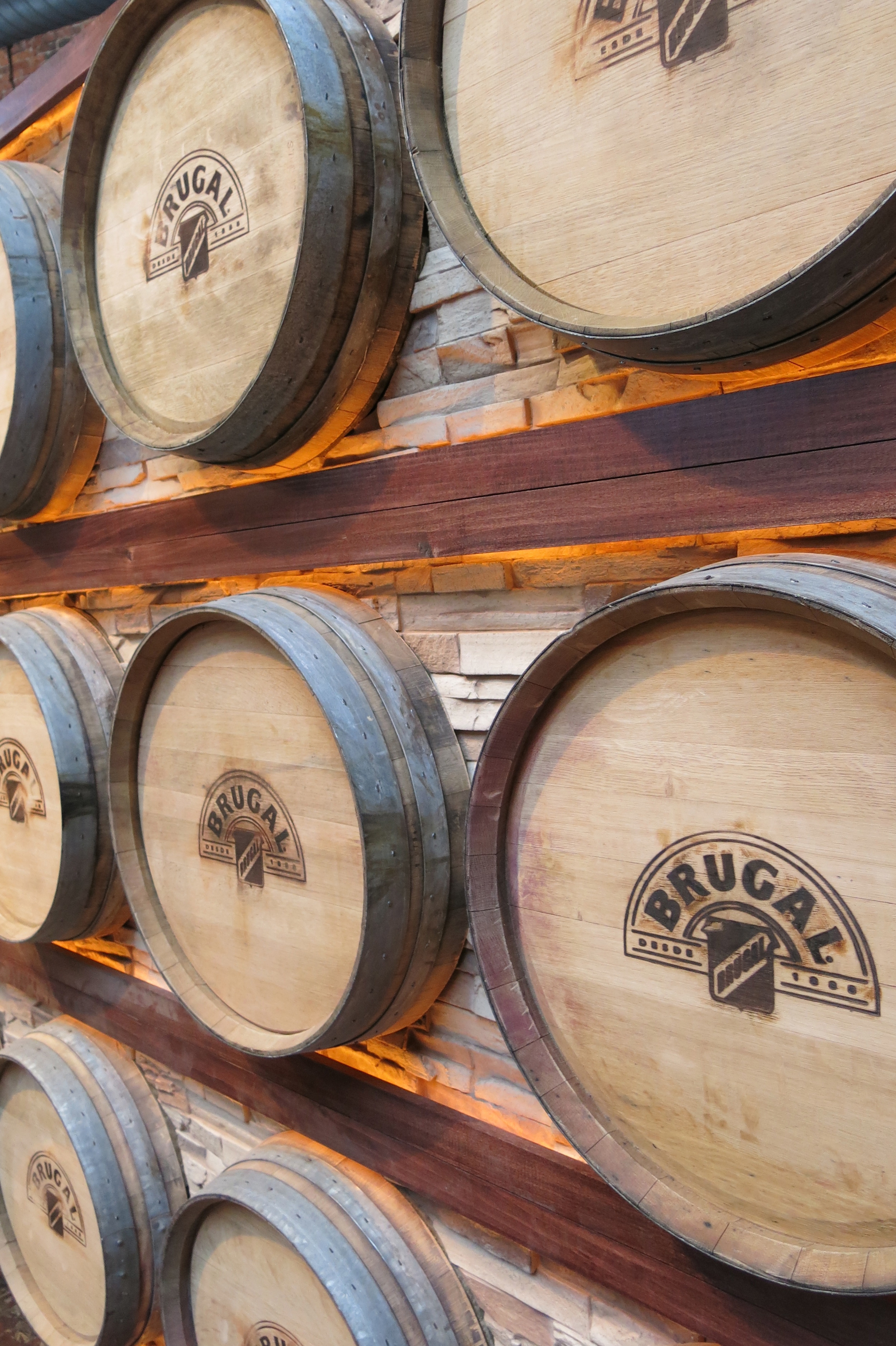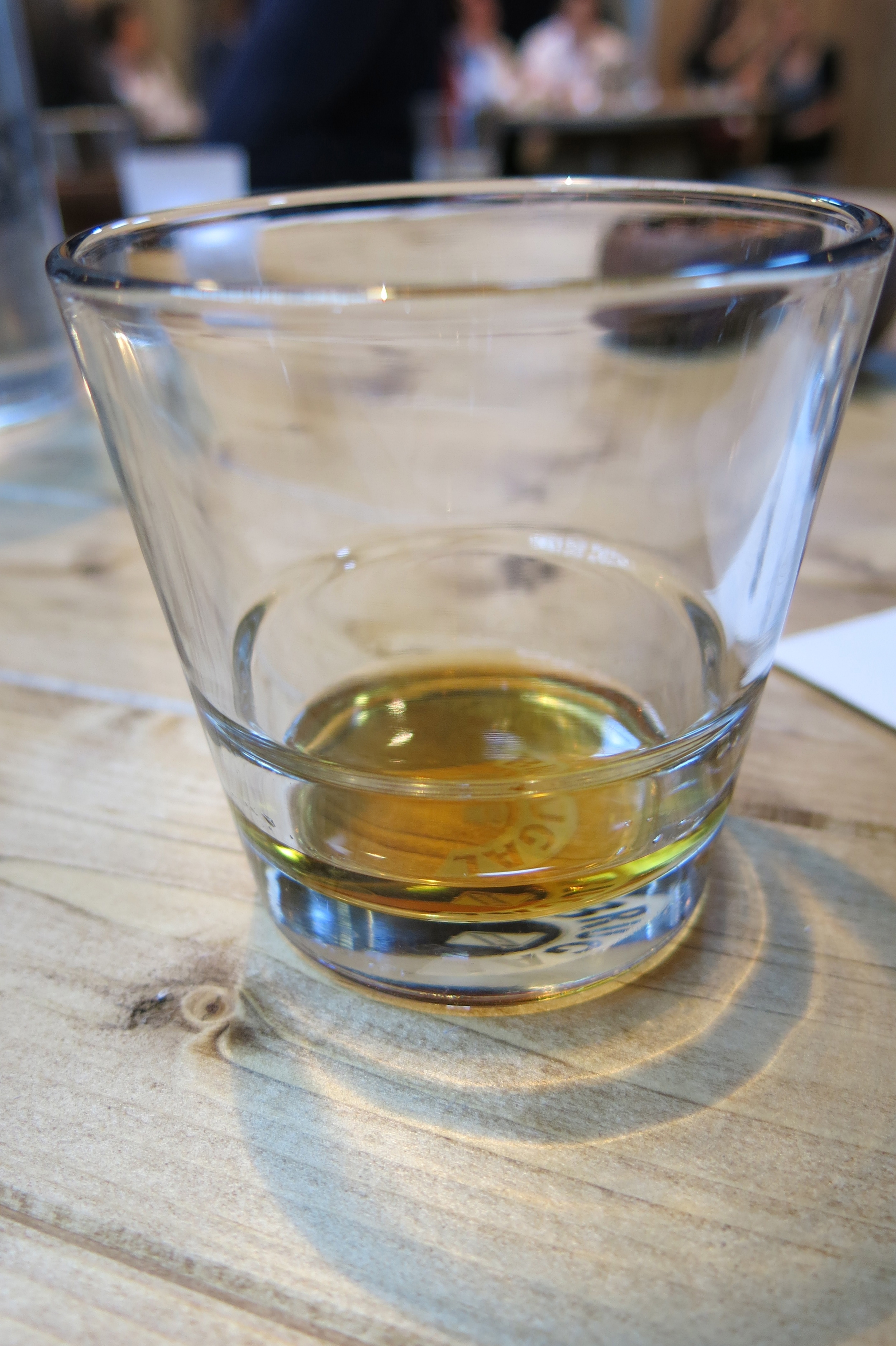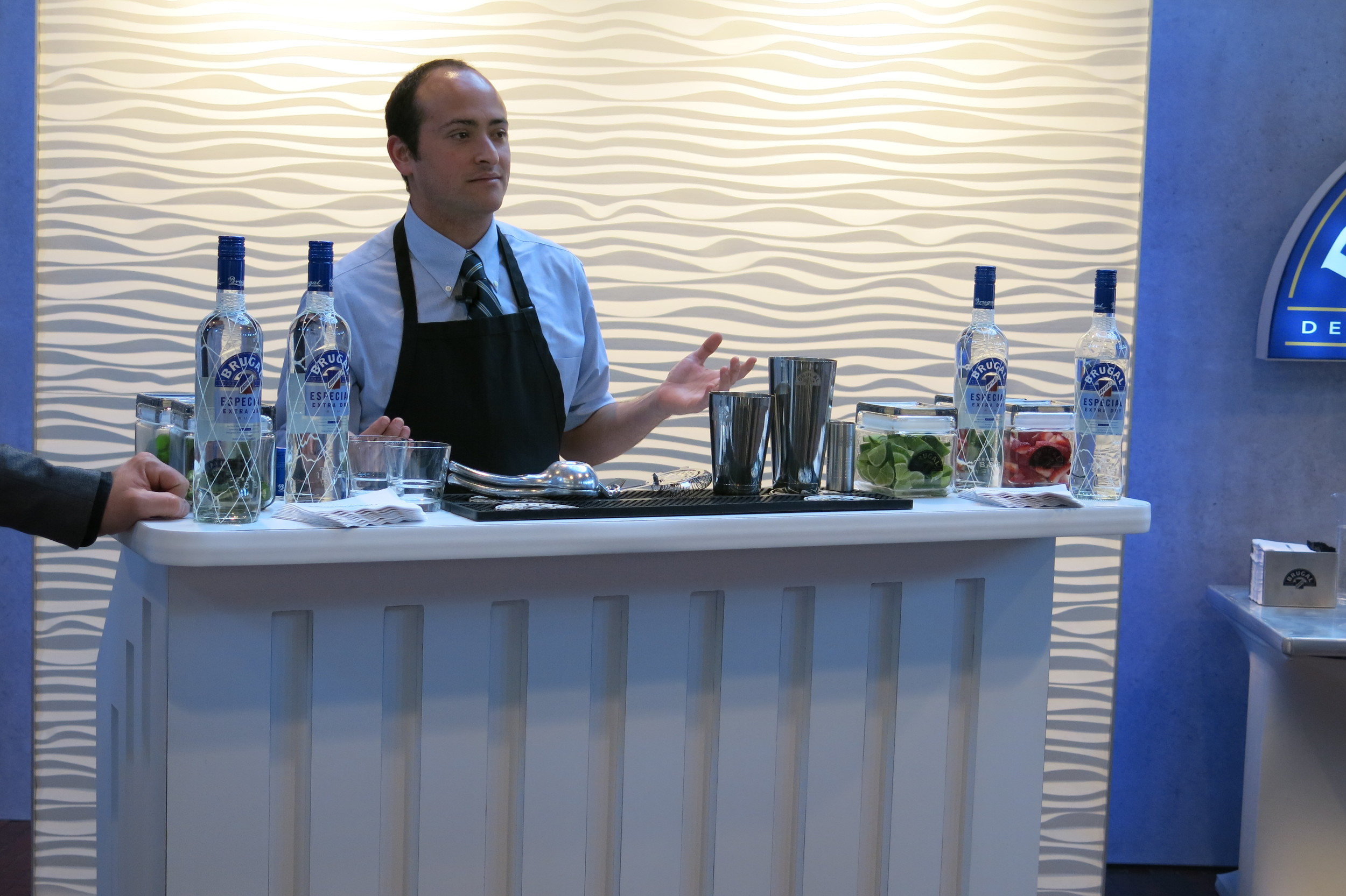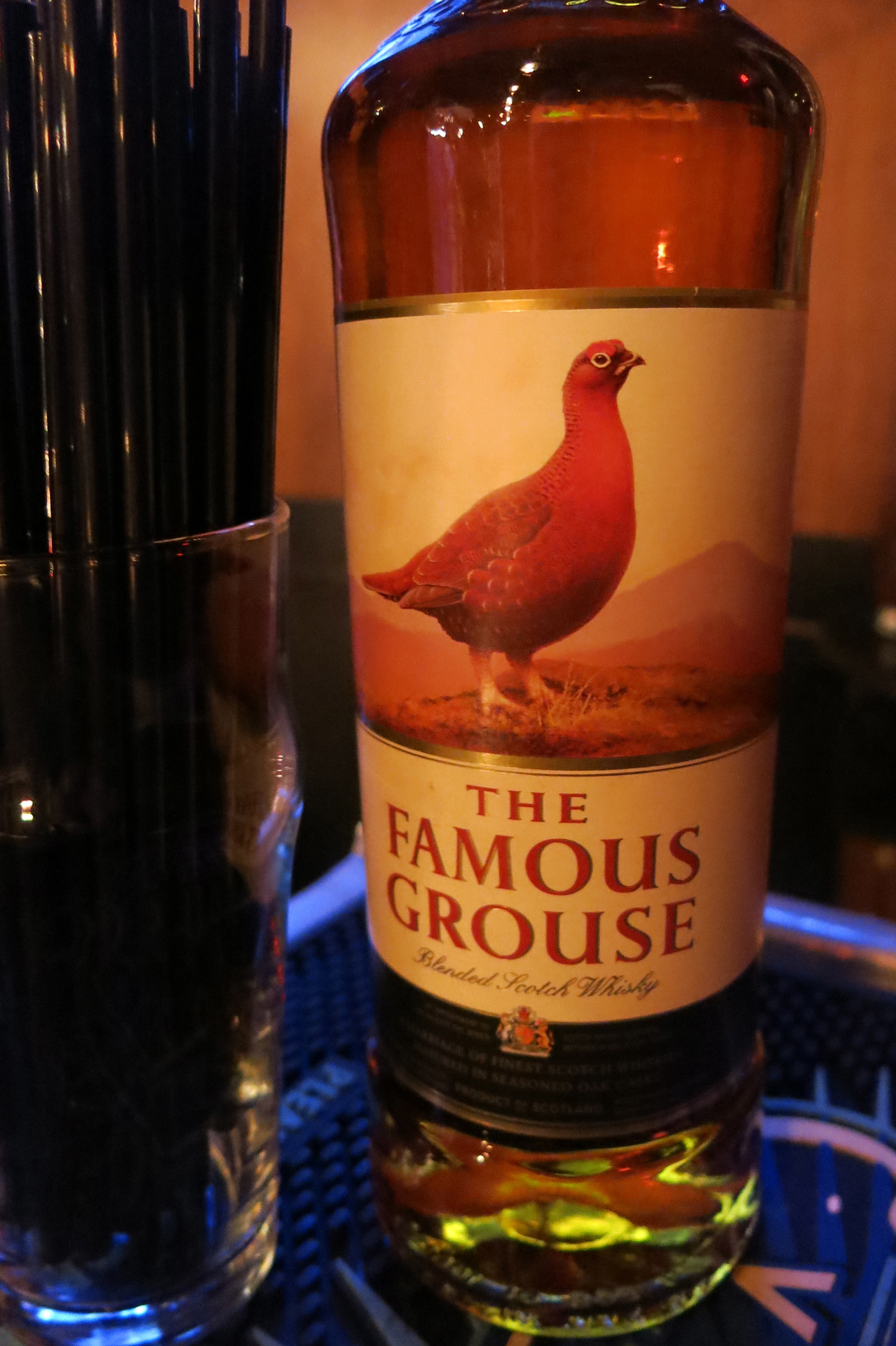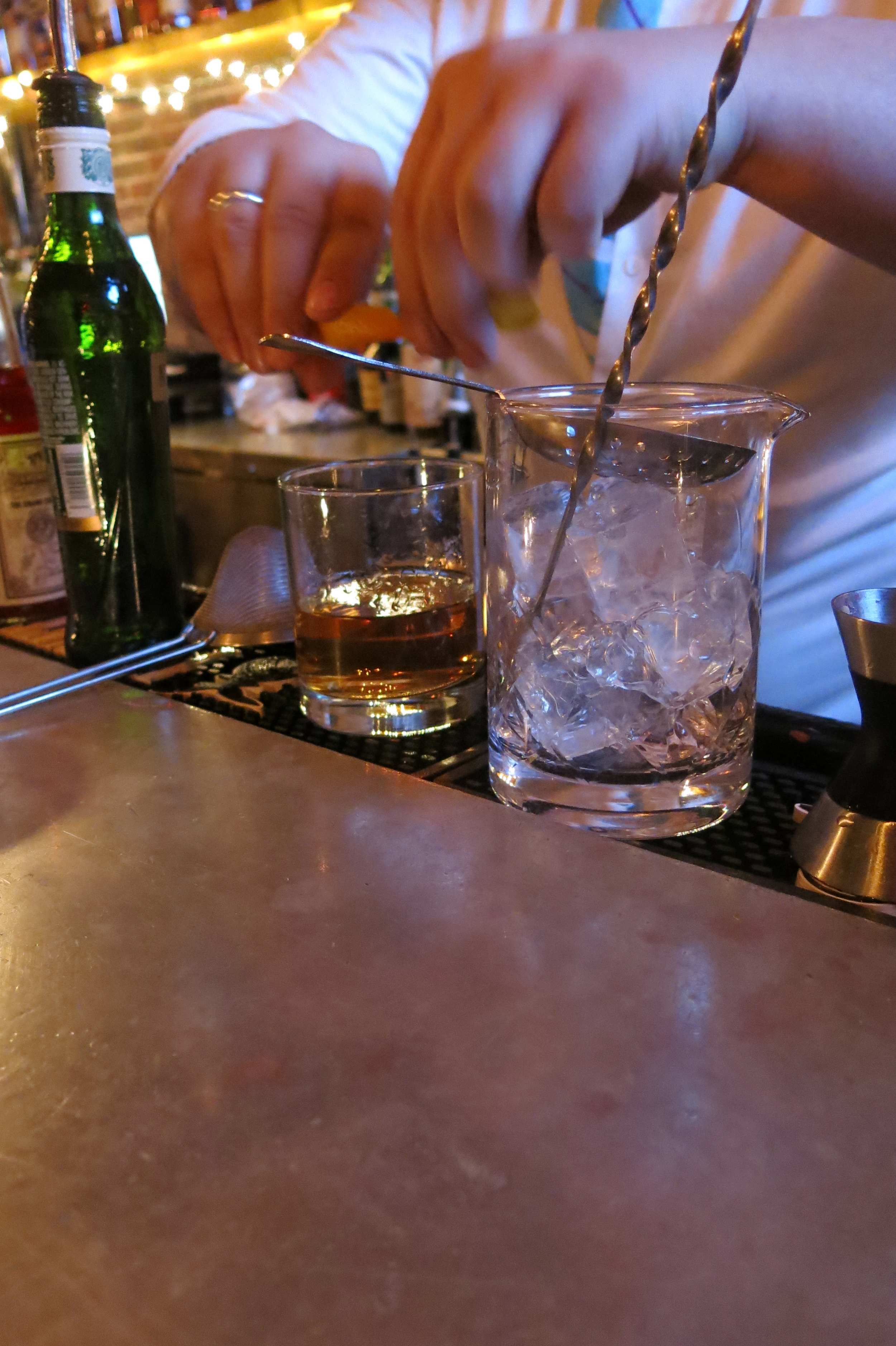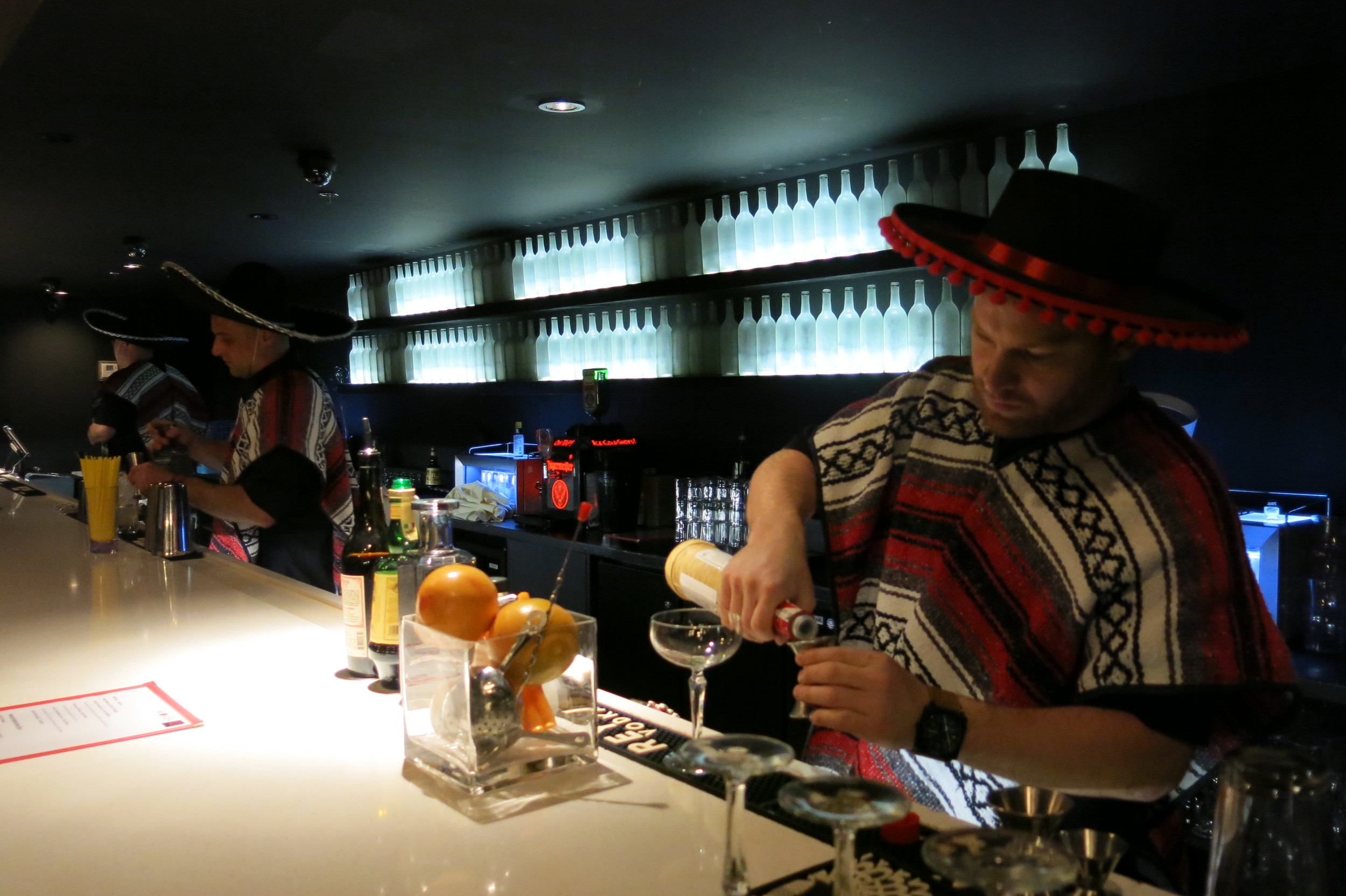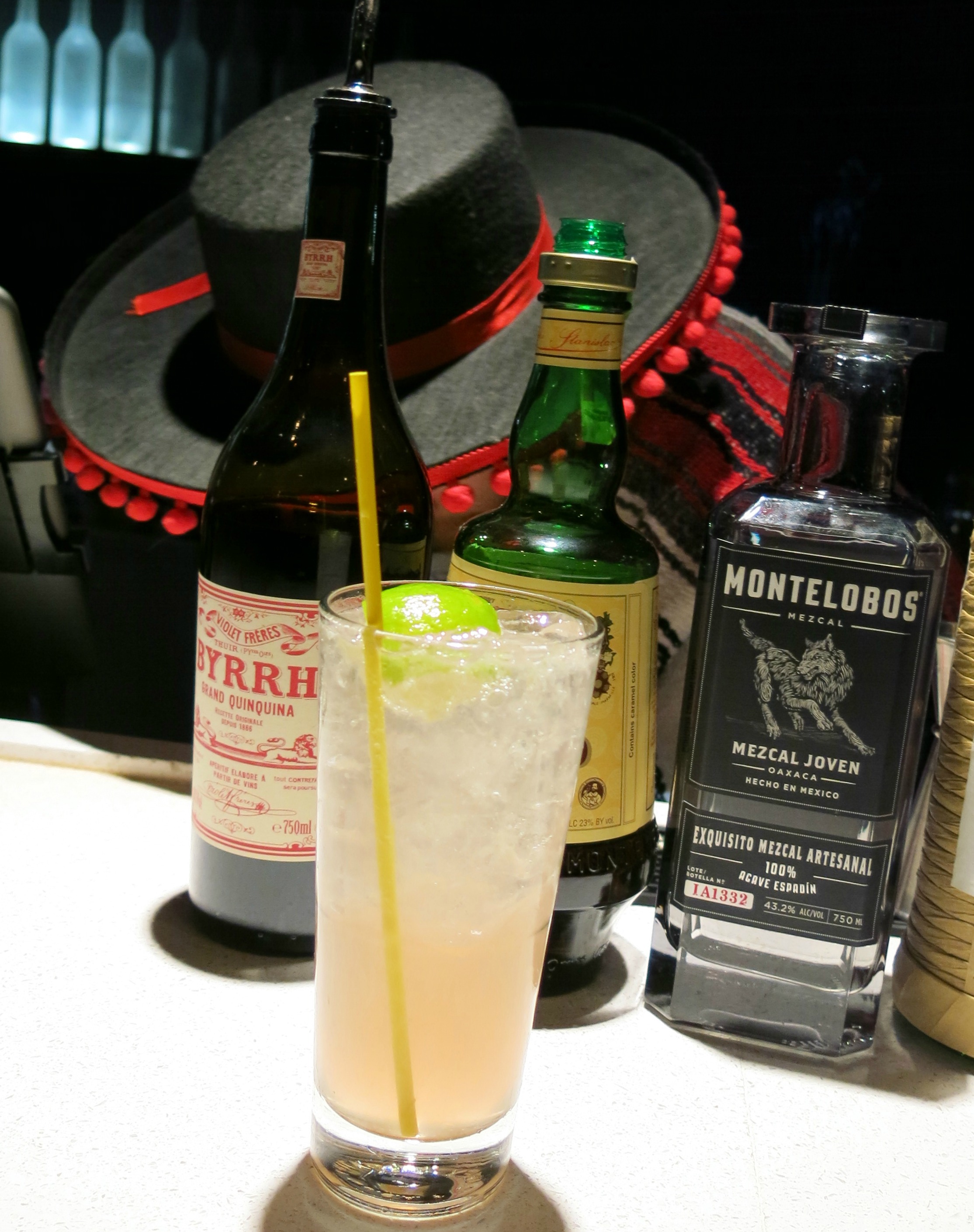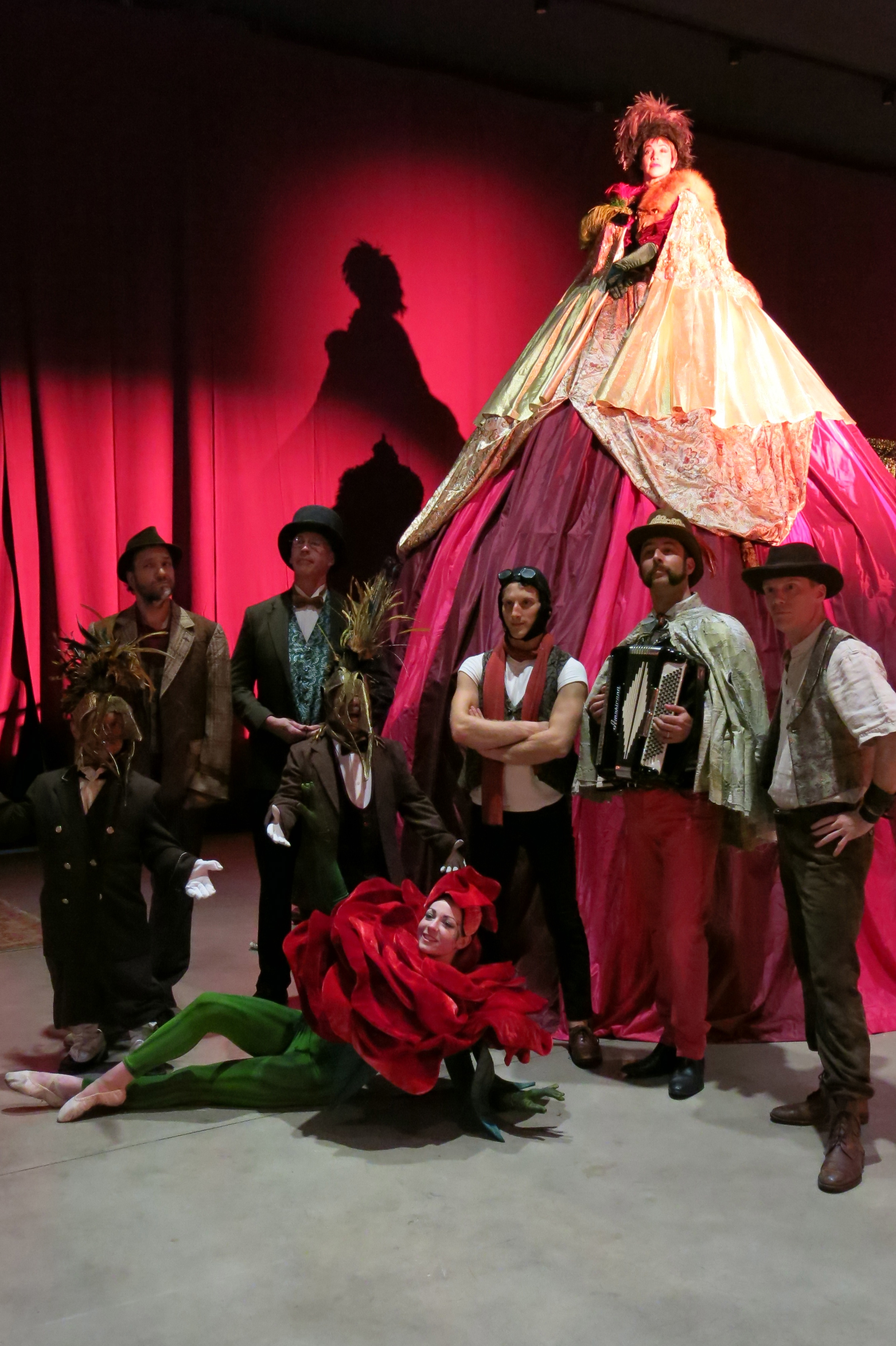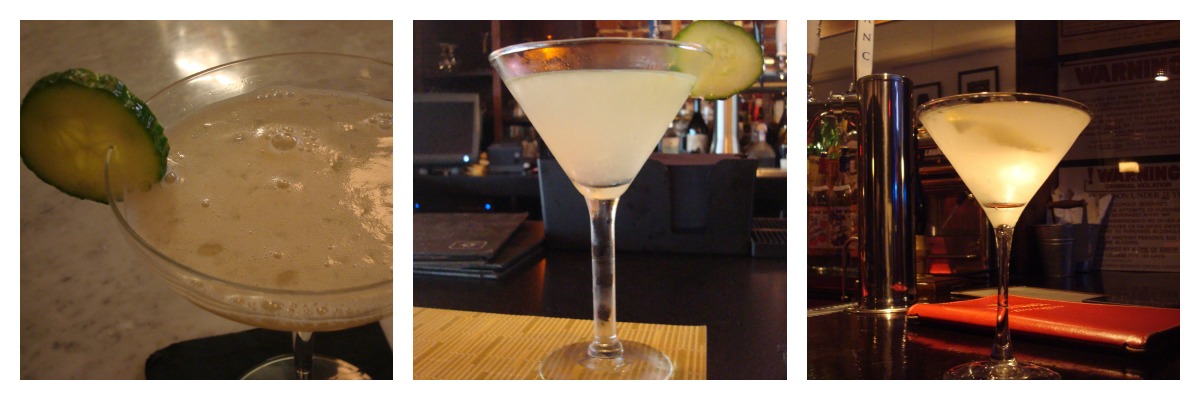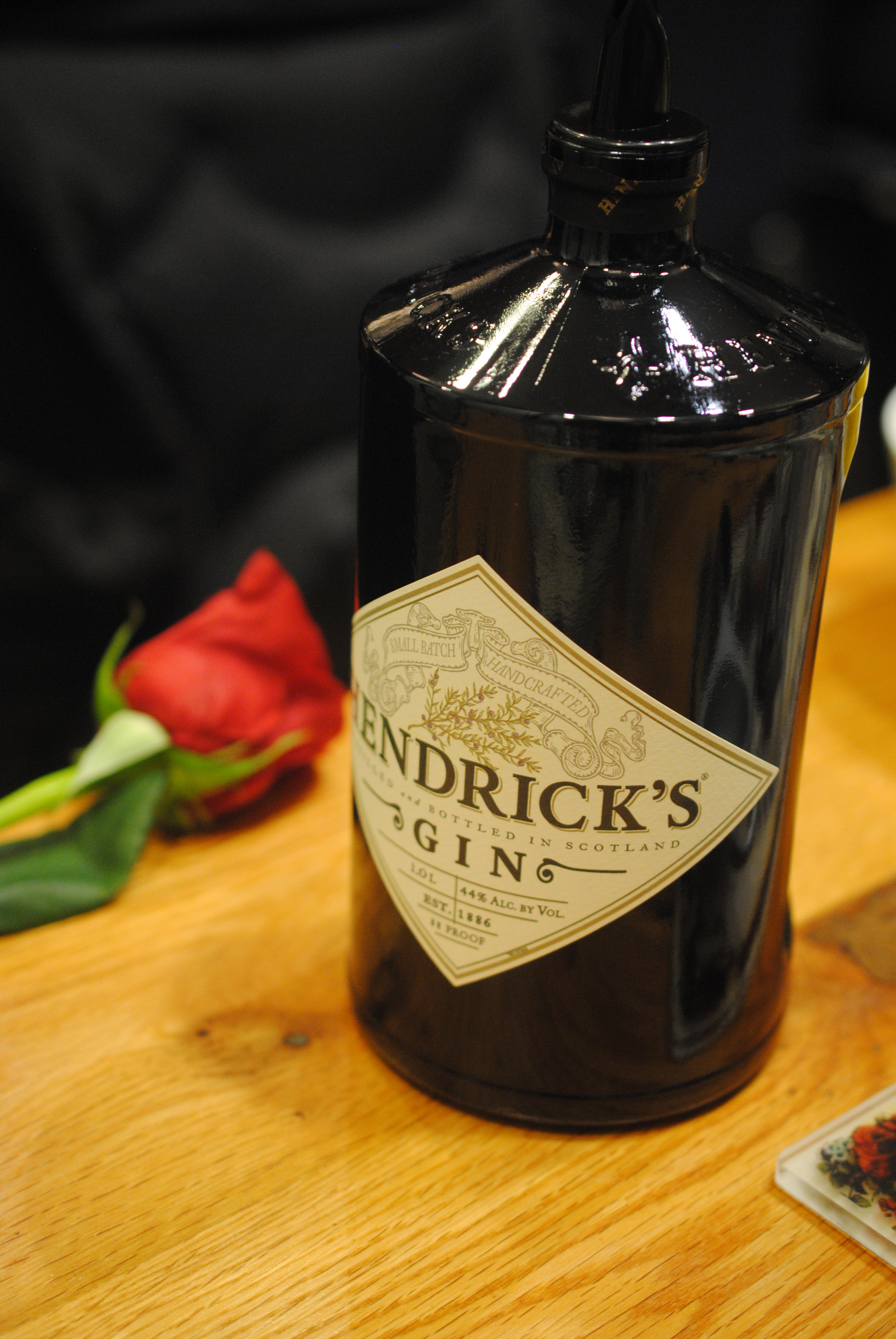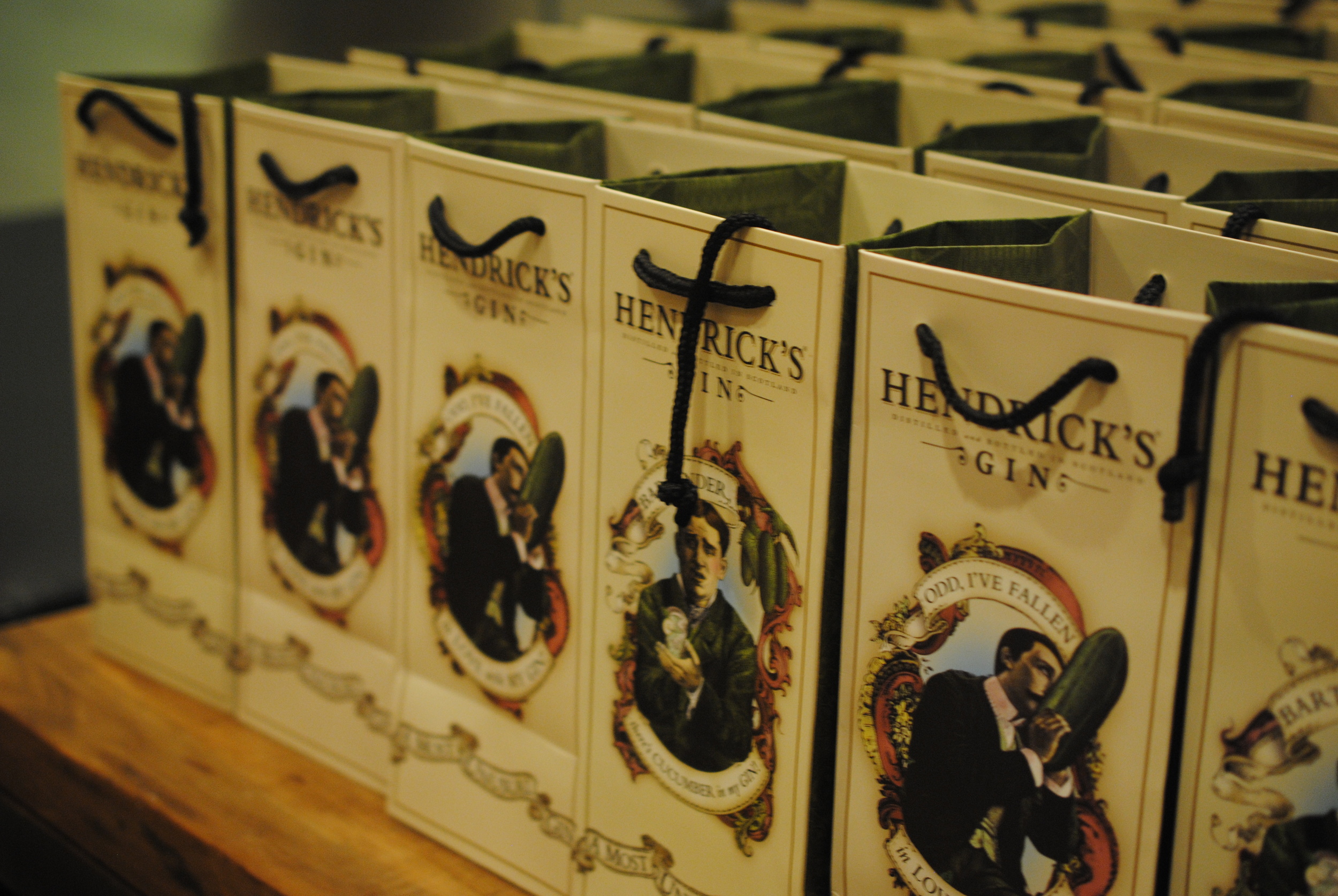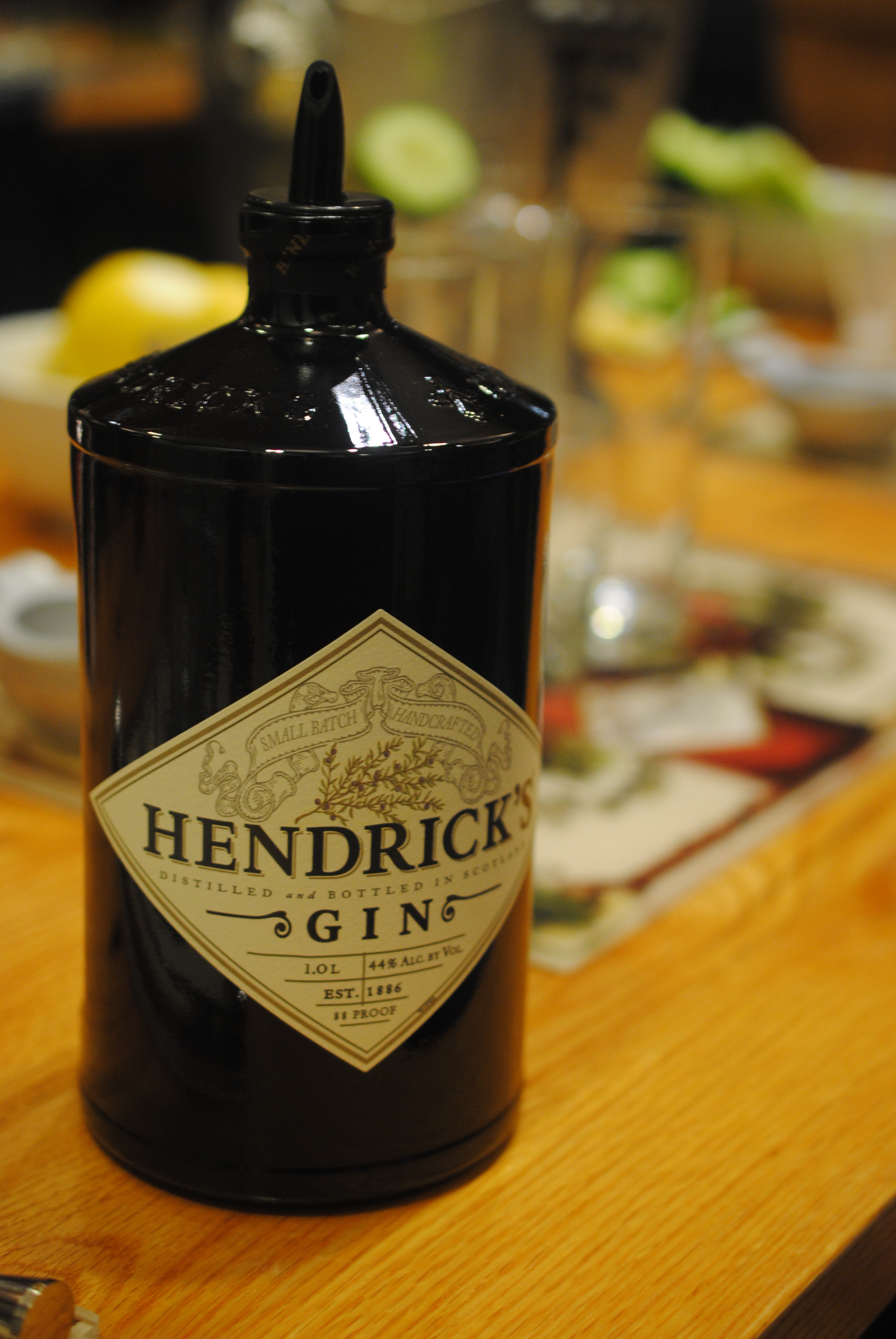Bully Boy Distillers
Running along one wall of the Bully Boy distillery is a shelf that holds a collection of dusty, empty liquor bottles.
The labels – faded, smudged, and grimy – advertise dubious contents such as “Very Old Cow Whiskey” and “Pale Brandy.” A “Fine Old Medford Rum” looks anything but fine, though it’s definitely old. Even familiar brands like “Bacardi Rum” are a little suspicious when their names are typed onto ordinary household labels.
A closer examination of those labels – particularly the dates, which stretch back to the 1920s and 1930s – reveals why the names are so unusual and the contents so questionable. This was bootleg liquor. In an era when Prohibition is endlessly glamorized and so many bars try to recreate the experience of drinking in a speakeasy, these bottles are the real thing – a tangible, authentic connection to a period of American history that mystifies and fascinates us to this day.
But to brothers Will and Dave Willis, owners of Bully Boy Distillers, the bottles are more than just artifacts. You might say they’re family heirlooms. The bottles once belonged to the Willises’ great-grandfather, who locked them away in a vault on the family’s farm in Sherborn, Massachusetts.
Will and Dave discovered the vault in the basement of their farmhouse when they were kids, but it would be some time before they appreciated the significance of their find. And while there’s no evidence that their great-grandfather had any role in making the hooch, there’s little question that his farm was the place to be back when booze was banned.
“On a lot of the bottles, our great-grandfather would write all the names of people who were at the drinking session,” Dave tells me during a tour of his Roxbury distillery. “It’s incredible, all these old signatures on the label from the 1920s and earlier. It’s a nice tie-in with where we came from and what we’re doing here.”
What they’re doing is making a line of small-batch spirits that have fed consumers’ demand for artisanal liquor and given bartenders a slew of unique options for creating innovative cocktails. Bully Boy Distillers opened their doors in 2011, the first legal craft distillery to set up shop in Boston in decades.
Four years later, Bully Boy is one of the most recognizable liquor brands in the city. Their spirits have become go-to options at a host of local establishments and are integral to any number of signature cocktails.
And while their distribution is presently limited to Massachusetts, Rhode Island, and New Hampshire, their growing product line has garnered recognition and praise from across the country – at the front of the distillery is a shelf full of bottles adorned with gold, silver, and bronze medals won in numerous national spirit competitions.
Those award-winning spirits are situated just a few yards from the old bootleg bottles, and while they’re oceans apart in terms of quality, it’s not difficult to discern a connection. Growing up on that same Sherborn farm, the Willis brothers experimented with making hard cider before learning the finer points of distillation – using a five-gallon stovetop still.
And despite the success they’ve enjoyed in their first four years as professional distillers, the Bully Boy operation remains small in scale, with Will and Dave toiling under fairly harsh conditions.
Their utilitarian distillery is in a nondescript warehouse that you won’t find without a reliable GPS unit. Inside are the tools of the trade, and little more – a 150-gallon still, fermenters, storage containers, empty bottles waiting to be filled, and a room with rows and rows of oak barrels. In the summer months, temperatures in the distillery can soar to 120 degrees.
“It is so hot in here, which is brutal,” Dave wearily acknowledges. “Obviously you sweat all day long. It’s a really tough environment to work in, but it’s awesome for aging, because the barrels swell.”
Pointing to the barrels, he notes that small quantities of spirit and sap can be seen oozing out of the seams, and he explains the benefits of that presumably sticky process.
“The wood really expands when it heats up,” he says. “And then the spirit inside the barrel also expands and pushes up through the wood. It extracts all sorts of wonderful flavors and aromas from the barrel, and in the winter the barrel contracts when it gets colder.”
Bully Boy uses each of its barrels twice – first for their American Straight Whiskey, then for their Boston Rum. And while the aging process may seem fairly straightforward, Dave explains that there’s more to it than most people know.
“Barrel aging is one of these really mysterious things that treatises are written on,” he claims. “And the wonderful thing about it is, there’s a lot about barrel aging that no one has an answer to. So it’s kind of this cool, mythical part of the whiskey making and rum production process.”
After a short lesson on barrels, Dave walks us through the distillation process, from mash tun to fermenter to still, and ultimately, to barrel or bottle. I won’t even try to explain the process in the detail that Dave can, but the tour is entertaining and informative.
After that, it’s time to sample the goods. Bully Boy currently offers six products, each made with locally sourced ingredients whenever possible, including Boston water.
Vodka
The tasting begins with their vodka. Using red wheat as a base, the vodka is clean and bracing, with a hint of sweetness, but no burn whatsoever.
White Rum
Made with blackstrap molasses, Bully Boy White Rum is less sweet and more robust than typical white rums, with a distinct fruitiness. Dave explains that white rums have historically gotten a bad rap because of a certain large rum distillery that dominates the global market with a product that’s largely flavor-neutral.
“We tried to create a white rum that has more to it,” he says. “There’s no point in coming out with another neutral, molasses-based white rum. If you’re going to do a white rum, or any spirit, you want to do something that’s got some uniqueness to it.”
White Whiskey
And on that note, Bully Boy’s white whiskey may be their most notable contribution to the world of spirits. Unaged whiskies had been steadily growing in number and popularity around the time Bully Boy started selling theirs, but most distillers seemed more interested in efficiency than quality. Not having to age the whiskey means saving money and time, and while some producers made quality white whiskies, others just ratcheted up the novelty factor (think corn whiskey and “moonshine” sold in mason jars).
Dave explains that the key to making a good white whiskey is treating the spirit differently than one intended for aging.
“The mistake that a lot of people make with unaged whiskey is they simply take the stuff that they would put in a barrel and they stick it in a bottle,” he says. “If you’re not going to get the benefit of the barrel, you’ve got to create the cleanliness through the distillation process and the choice of grain.”
Bully Boy uses wheat for its white whiskey, which is fruitier and more subtle than the typical corn base, and distills the spirit at a higher proof. The result is a clean flavor that pulls from several spirit types, like tequila, gin, and grappa, but still has the graininess of whiskey.
While it can be enjoyed neat or on the rocks, Dave thinks of the unaged product as a cocktail whiskey. “There are cocktails you can make with unaged whiskey that you cannot make with any other spirit, so again it’s really adding something to the world of spirits,” he says.
American Straight Whiskey
Bully Boy’s American Straight Whiskey, on the other hand, is made with sipping in mind. Aged in American oak barrels, the whiskey’s blend of grains – corn, rye, and malted barley – give it a balanced flavor, with a bourbon-like sweetness up front and spicy rye notes in the back.
Boston Rum
Bully Boy’s other aged product, Boston Rum, hearkens back to Boston’s pre-Prohibition glory days as a center of rum distillation. Made with blackstrap molasses, it’s lighter and fruitier than typical dark rums, which often have caramel coloring and sugar added to them. The barrel aging contributes some complexity but doesn’t overwhelm the flavor.
Hub Punch
Finally, the Willis brothers again demonstrate their appreciation for history with one of their more unusual products. Hub Punch is inspired by a recipe that was popular in Boston in the 19th century but slipped into obscurity during Prohibition.
Mimicking the lost formula, Bully Boy infuses their Boston Rum with fruits and botanicals for an herbal, fruity spirit, with understated notes of tea and licorice. Dave says it’s best in cocktails, which is how our local forebears apparently consumed it. Mixed with ginger ale, soda water, and lemon, the Hub Punch cocktail is a portal back to Boston drinking culture in the years leading up to Prohibition.
The Hub Punch is only the most recent instance of regional history informing Bully Boy’s otherwise modern craft. Even the company name ties back to the family farm. Will and Dave’s great-grandfather named his favorite workhorse “Bully Boy” after a phrase coined by his college roommate – future U.S. president Theodore Roosevelt.
And then, of course, there’s that vault of timeworn bootleg liquor. I can’t resist asking Dave my most burning question – has he ever sampled his great-grandfather’s stash? He replies in the negative, explaining that the bottles are in even worse condition than they appear. Most of the corks have degraded and, if you look closely, you can see a layer of sludge at the bottom of the bottles.
But by the tone of his voice, I can tell he’s considered it. The contents would certainly be disgusting, and possibly even toxic. And yet, just one sip would be like going back in time. How many people alive today have tried that stuff?
“I’ve been tempted,” he concedes. “But….I have two kids now, and uhh…”
Fair enough. And despite Will and Dave’s ties to the past, their future is much more pressing. Next spring they’ll release their first gin, and a wheated bourbon is a few years away.
They’re also moving on up – later this year, they’ll be leaving their current distillery for a new, larger facility with more advanced equipment and a tasting room that will overlook the production floor. Dave becomes particularly animated when talking about Bully Boy’s future home, promising it will be a major upgrade from the current environment.
And a very long way from a stovetop in their family farmhouse.
Address: 35 Cedric Street, Boston
Website: www.bullyboydistillers.com
* * * * * * * * * * * * *
Copyright © Boston BarHopper. All Rights Reserved.
Tanqueray Bloomsbury
If you’re a gin drinker, this is a good time to be alive. Not only has the herbal spirit enjoyed a global surge in popularity in recent years, but the advent of craft distilling has introduced a stunning array of small-batch gins to the market. With so many products to choose from, it’s almost hard to remember the time when our choices were limited to just a handful of major labels. Of course, those long-established brands still dominate the market, unthreatened by the multitude of tiny upstarts. But some of the big guys seem to have taken notice of gin drinkers’ evolving tastes. Gordon’s gin, one of the oldest gins in the world and still the best selling, in recent years introduced a cucumber gin and an elderflower gin. Another titan, Beefeater, began offering a barrel-aged gin a couple of years ago.
And then there’s Tanqueray – the sexiest of traditional London dry gins and the subject of this week’s post.
With roots dating back to the early 19th century, Tanqueray is among the oldest and most renowned gin brands on the planet. I’ve always found it to be the most alluring, as well. Something about that iconic green bottle, with its waxy red seal, commands respect as it evokes a sense of mystery.
As timeless as Tanqueray London Dry may be, the brand remains open to a little experimentation. The venerable distiller has debuted a series of limited-release gins in the past few years, beginning with Tanqueray Malacca, a spiced gin, in 2013. Tanqueray Old Tom followed a year later. And just last month, the gin distiller unveiled its newest variation – Tanqueray Bloomsbury.
It’s not quite accurate to call Bloomsbury “new.” The gin draws its inspiration from a recipe by Charles Waugh Tanqueray, son of founder Charles Tanqueray, that dates back to 1880. The name derives from Bloomsbury, England, the London district that the Tanqueray distillery once called home. Whereas Tanqueray’s London Dry employs four botanicals in its recipe, Bloomsbury uses five – a special “Tuscan juniper,” angelica, coriander, winter savoury, and cassia bark.
Before I tried the new variation, several people remarked to me that Tanqueray Bloomsbury is “very juniper-forward” – a characterization I found somewhat amusing. The juniper berry is what gives gin its distinctive, pine-like flavor, and that quality is prominent in all English gins. So describing Bloomsbury as “juniper forward” seems kind of like describing a steak sandwich as “meat forward.” But I got a chance to try it out for myself this past week, when brand ambassador Rachel Ford – affectionately known as Lady Tanqueray – stopped by the Sinclair in Harvard Square to show off the Bloomsbury and demonstrate its versatility in cocktails.
The event was marked by the elegance you might expect of such a classic English brand – candles and bouquets of flowers adorned the tables at the Sinclair, and soft lighting set the mood for sipping gin and indulging in easy conversation. The featured spirit was available for sampling, and given the way the Bloomsbury was described to me, I was expecting an intense blast of juniper. Yet I found it to be surprisingly soft and wonderfully floral. It’s definitely juniper-forward, but the botanicals are well balanced, with notes of spice and, less prominently, licorice. It differs noticeably from the London Dry but clearly remains within the Tanqueray family in terms of style and overall flavor profile.
With that established, it was time to see how the Bloomsbury fared in cocktails. And why not start with the most iconic of gin drinks? The Bloomsbury Martini featured the specialty gin, dry vermouth, and your choice of olive or lemon (mine is always the latter). This traditional cocktail truly showcased the Bloomsbury, with vibrant notes of juniper and just enough dryness to make it a bracing, slow-sipping drink.
The Satisfaction lived up to its name. This bold cocktail combined Bloomsbury, cranberry, cucumber, ginger liqueur, and lime. It was an impressive mix of flavors that were expertly balanced, making for a smooth, refreshing drink.
The Ramble On, meanwhile, was simpler in composition but surprisingly complex in its flavor. A mix of Bloomsbury, Becherovka, agave, and lemon, a prominent cinnamon flavor accompanied the floral notes of the gin in this sour drink.
Tanqueray has been making gin for nearly two centuries and remains a market leader to this day. The brand has no need to reinvent itself. But as the gin market gets more crowded and new voices join the conversation, Tanqueray’s occasional product diversification is a way to engage new audiences and capitalize on our evolving definition of what constitutes an outstanding gin. And by revisiting one of its own recipes instead of chasing the latest trends, Tanqueray demonstrates that its brand can be traditional and dynamic at the same time.
* * * * * * * * * * * * *
Copyright © Boston BarHopper. All Rights Reserved.
Glendalough Distillery and the Independent Spirit
Ireland’s history of distillation is as turbulent as it is long.
At its height of production in the 18th and 19th centuries, the small island boasted 200 licensed distilleries and perhaps as many as 2,000 illicit ones. But heavy taxation, regulation, two world wars, and the loss of a certain large customer due to Prohibition brought the industry to its knees, leaving only a handful of distilleries in operation to this day.
Loss of Independence – and Identity
Most of the remaining distilleries have ensured their survival by allowing themselves to be purchased by multinational conglomerates with multiple brands under their respective umbrellas.
That bittersweet progression reached a culmination of sorts in January 2012, when the last independently owned whiskey distillery in Ireland passed into foreign hands.
Now in one sense, this isn’t all bad news. Deep-pocketed corporations pouring money into a domestic brand can create or sustain jobs, modernize aging facilities, and open up new markets in far-flung regions.
But for a nation that cherishes its independence the way Ireland does, it must be galling to know that some of its most beloved products amount to little more than a line item on some foreign company’s balance sheet.
And while Irish whiskey has enjoyed an international renaissance in the past five years, there’s something perverse about Bushmills whiskey being owned by Jose Cuervo.
The Return of Craft
But Donal O’Gallachoir is helping bring Irish distillation back to its roots. Donal is one of the founders and owners of Glendalough Distillery – the first craft distillery in Ireland.
Founded in 2011 as the brainchild of five friends from Dublin and Wicklow, Glendalough Distillery represents an effort to recapture the character and heritage of a centuries-old industry that’s had more than its share of ups and downs.
“We wanted to bring back something real, something historic,” Donal tells me over drinks at Fort Point’s Blue Dragon. Glendalough’s brand manager, Donal relocated to Boston last year and has been bringing the distillery’s growing line of spirits to American shores.
And while Glendalough is a young distillery, Donal and company have cloaked their brand in Irish history, from basing their spirits on ancient recipes and methods to adopting the figure of St. Kevin, a 6th century Irish abbot, as something of a spiritual guide.
The Legend of Kevin
While from a distance it might look like Gandalf preparing to take down a balrog, that’s St. Kevin on the label of Glendalough’s bottles. The founder of Glendalough, the beautiful valley in Ireland from which the distillery takes its name, St. Kevin is known to have been a fiercely independent holy man, though the actual record of his life is long on folklore and short on verifiable facts.
The most enduring legend involving St. Kevin, immortalized in verse by the late Nobel Prize-winning Irish poet Seamus Heaney, is that a blackbird once landed in his outstretched hand, and such was Kevin’s patience that he remained completely still for weeks while the bird built a nest and laid eggs, not moving until the chicks eventually hatched and flew off.
The blackbird story is an allegory of determination and independence, and it’s easy to see why a fledgling distillery would draw inspiration from the celebrated saint.
Those characteristics are evident as Glendalough continues its gradual rollout. The product line is small but growing, consisting of three aged whiskies, a gin, and a spirit that relatively few Americans may be familiar with – poitín.
Irish Moonshine
Poitín (pronounced put-cheen) represents a fascinating chapter of Irish history and culture. A spirit traditionally made from malted barley, sugar beets, and potatoes in a pot still, poitín predates whiskey and is considered one of the oldest distilled beverages in the world, first appearing in written record in 584 A.D. Irish authorities prohibited its distillation in the 17th century, but production continued in secret, making it the Irish equivalent of moonshine.
And once it retreated to the shadows, poitín became the stuff of legend, with an alcohol content ranging from 50% to as high as 95%. After 300 years of illicit production, poitín was approved for exportation in 1989 and finally for domestic sales in 1997.
Poitín’s historical credentials make it an entirely appropriate product for a distillery trying to recapture the essence of old-school Irish spirit production. “It’s the definition of craft distilling,” Donal says.
At 40% ABV, Glendalough’s Premium Irish doesn’t quite approach the organ-melting potency of homemade poitín. But the recipe is rooted in tradition, dating back to the 1700s. Made from a mash of malted barley and sugar beet and aged in Irish oak barrels, the clear spirit has the body of a single-malt whiskey but a sweet flavor that’s almost reminiscent of rum.
Consumed neat or on the rocks, Glendalough’s poitín has a somewhat creamy mouthfeel with an overall earthiness and a blend of fruits that we don’t encounter often on our side of the Pond, like gooseberries and blackcurrants. It makes for an unusual but appealing tasting experience.
It also works well in cocktails, and Blue Dragon’s Cliffs of Glendalough features a bold, coffee-infused poitín with rich notes of chocolate and spices.
Resurgence of Irish Whiskey
An unfamiliar spirit like poitín might require some explanation, but Irish whiskey needs no introduction. After decades of playing second fiddle to Scottish whisky – in terms of popularity, anyway – Irish whiskey has spent the past several years reclaiming its onetime international glory. 2011 marked the first year that Irish whiskey outsold single malt scotch in the United States, and the spirit’s been on a global upswing since then.
That makes the timing of Glendalough’s entry to the market fortuitous. They offer three whiskies – 7-year and 13-year single malts, and as of this March, an intriguing product called Double Barrel. Hearkening back to a 19th-century style, it’s a single-grain whiskey that spends three and a half years in an American bourbon barrel before being transferred to a Spanish sherry barrel for six months.
Double Barrel
The result is a whiskey with an oaky vanilla flavor and an unexpected fruit character. Donal calls it “light, sweet, and complex,” with depth from malted barley and sweetness from corn. It’s a very accessible whiskey, but surprising notes of spice, ginger, and nutmeg make it complex enough to interest a veteran whiskey drinker.
After sampling it neat, I ordered the Double Barrel in a cocktail, expressing no preference for the type of drink as long as it showcased the whiskey. Our bartender went all out and made “something special” – an Old Fashioned variation with the Glendalough Double Barrel, Benedictine, allspice-infused honey syrup, and old fashioned bitters.
Special indeed! The honey and spice smartly complemented the sweet and spicy notes in the whiskey, while the Benedictine added a bitter, herbal character.
Growth of a Brand
According to the Irish Spirits Association, Ireland exported about 6.2 million cases of whiskey last year, and that figure is projected to double by 2020.
Amid this rapidly increasing global demand, Glendalough Distillery is gradually carving out a small niche for itself. As of March 2015, you’ll only find their spirits in Boston, New York, Atlanta, and Washington, D.C., but the essence of craft distilling is starting small and worrying more about quality than sales figures.
And Glendalough seems content to build their brand not with flashy ad campaigns but by establishing relationships with bar owners, managers, and industry professionals – people who appreciate a small-batch spirit with a unique flavor profile that can feature in an original cocktail.
Irish Hospitality
Some good ol’ Irish charm doesn’t hurt either, as is evident during my conversation with Donal. Chatting with Glendalough’s brand manager is a genuine pleasure. The man has an inexhaustible supply of stories about his native Ireland, the history of Irish distilling, the spirits industry in general, his favorite Boston bars, you name it.
But it’s more than just idle chatter. Entertaining tales and anecdotes aside, Donal’s passion for Glendalough’s spirits is unmistakable, as is his respect for Ireland’s distilling heritage. The Emerald Isle's spirit industry is one of the oldest in the world and has endured staggering swings of fortune, from once having hundreds of distilleries to being nearly wiped out to having all of its major producers bought up by foreign investors.
Donal and company are adding a new chapter to that dramatic narrative.
And while it’s all well and good that huge corporations are bringing Irish whiskey to every corner of the globe, small craft distilleries like Glendalough are getting back to what made the stuff so popular in the first place.
“You can look back on it and say, I made that,” Donal remarks as I admire a bottle of his whiskey.
Call me idealistic, but that seems more satisfying than saying “My company bought the company that made that.”
* * * * * * * * * * * * *
Copyright © Boston BarHopper. All Rights Reserved.
Numbing the Pain of Snowpocalypse With Local Spirits
If you know me at all, even just as an occasional visitor to this space, then you are doubtless familiar with my loathing of winter. My disillusionment with this irksome season probably dates back to the moment my parents decided I was old enough to operate a shovel. In all likelihood, that was the first time I realized that a snowstorm meant more than just an impromptu day off from school, an occasion to be occupied with such leisurely pursuits as snow fort construction and sledding. Suddenly, there was work involved – forced manual labor in harsh conditions. At the time, I certainly didn’t appreciate the gravity of the moment, unaware that it was my indoctrination into a lifetime of arbitrary inconvenience between the months of November and April (give or take a few weeks). That realization came gradually, in the form of sore muscles, untimely falls, white-knuckled car rides, and the abandonment of long-scheduled plans. This year, it’s meant impossible commutes in and out of the city, subzero temperatures, and ice dams forcing water into my dining room.
I tell you this not because I think you need to hear another person complaining about the weather, but because this menace of a winter has become an encumbrance on my weekly posts. Of course I realize, fully, that my having to postpone a couple of bar visits doesn’t exactly qualify as a hardship. But in the face of parking bans and the utter catastrophe that is the MBTA, I’ve been hampered in my efforts to share a tale of barhopping on my preferred schedule of once a week.
It was in the midst of this frustrating, snow-induced torpor that, late one night, I decided to treat myself to a glass of bourbon; specifically, Berkshire Mountain Distillers bourbon, a bottle of which was given to me by my friend and fellow barhopper Kat. I had opened the bottle some time ago and used it in a cocktail or two, but had never tried it on its own.
And let me tell you – it was a revelation. The inviting aroma, the smooth texture, the notes of caramel in the finish; I felt revived.
Now my intention here is not to anoint Berkshire Bourbon as the king of whiskies. I’d call it a good, solid spirit, and a genuine pleasure to drink. But given the circumstances of that particular night, it felt like something more. I wanted no other bourbon than that which I’d just poured into my glass.
The episode also provided some much-needed inspiration. I considered writing a short piece about my experience with Berkshire, but then decided to expand it to include some of the other local spirits I’m fortunate to have in my collection. I’ve long been an advocate of drinking locally, but I think that takes on another layer of significance when the region is affected by something like this brutal stretch of winter weather. If you pour yourself a well-earned drink after a marathon shoveling session or a painful commute, there’s a certain kinship in knowing that the booze in your glass was made just a few miles away, by people who are enduring the same frustrations.
That said, here’s a tribute to three local distilleries that are cranking out top-notch products in and for a state that’s been driven to drink by the 100+ inches of snow we’ve racked up over the past month.
We begin with the inspiration for the post.
Berkshire Mountain Distillers – Bourbon
As the name would imply, Berkshire Mountain Distillers makes its home in Massachusetts’ mountainous Berkshire County. When BMD set up shop in 2007, it did so as the first legal distillery in the Berkshires since Prohibition. Their line of handcrafted spirits has grown to include rum, vodka, and several varieties each of gin and whiskey. A few of their offerings have won awards, and all of them have won praise among discerning drinkers.
Berkshire Bourbon is made with corn grown on a farm near the distillery and aged in American white oak barrels. It isn’t aged terribly long; like any young distillery, BMD is unable to speed up time to produce a 10- or 12-year-old spirit. But if it lacks some of the complexity of an older bourbon, its smoothness, aroma, and flavor more than compensate. It’s an approachable, easy-drinking bourbon with just enough bite and a hint of spice; prominent notes of caramel and vanilla give it an overall sweetness. I’ve found Berkshire Bourbon makes a mean Old Fashioned, but after my winter’s eve epiphany, I’m drinking it neat from now on.
Website:http://berkshiremountaindistillers.com/
* * * * * * * * * * * * *
Bully Boy Distillers – Hub Punch
While Berkshire Mountain Distillers was the first legal distillery to open its doors in the Berkshires since Prohibition, Bully Boy was the first to do so in Boston. And yet, Bully Boy’s roots date back to the days of that so-called Noble Experiment. Bully Boy’s owners, brothers Will and Dave Willis, trace their distilling roots at least as far back as the 1920s, when liquor was quietly available on their family’s farm in Sherborn, Massachusetts. Today their small-batch distilling is entirely legal, and yet there’s an obvious appreciation for history in their ever-expanding product line.
Hub Punch is a most intriguing elixir. Inspired by an 1800s-era recipe associated with a long-shuttered New York hotel, Hub Punch infuses Bully Boy’s barrel-aged rum with a blend of fruits and botanicals. The result is an unusual combination of fruity and bitter components, giving an unexpected herbal bite to a spirit normally known for its sweetness. Consumed neat, it’s drinkable but intense, with a fruit-forward character. It’s excellent in a cocktail, though, and Bully Boy offers a few recipes on their website.
The most traditional partners for Hub Punch are ginger ale and soda water, as with the eponymous “Hub Punch” cocktail. This mix of Hub Punch, ginger ale, soda water, and lemon is a crisp, fruity, refreshing drink with a hint of tartness.
Website:http://www.bullyboydistillers.com/
* * * * * * * * * * * * *
GrandTen Distilling – Fire Puncher Black
Last summer I visited GrandTen Distilling’s historic South Boston facility for an up-close look at small-batch spirit production. While there, I had the pleasure of sampling eight of their nine products. Why not all nine? Because they were out of Fire Puncher Black – a seasonal offering that combines GrandTen’s chipotle vodka with cocoa nibs from Somerville’s Taza Chocolate.
I finally got to try the spirit later that year when GrandTen hosted a bartender battle at its site. As part of the final round of the competition, two contestants were asked to create original cocktails using Fire Puncher Black. And you know, that’s no mean feat. With its complex blend of spicy pepper and dark chocolate, Fire Puncher Black is not exactly the most versatile of spirits.
It’s definitely fascinating to drink on its own. You get chocolate in the aroma, pepper in the first sip, and a finish that’s neither too hot nor too sweet. But if you’re looking to use it in a cocktail, GrandTen offers a few ideas on their website, the most exciting of which is called Joe vs. The Volcano.
Named for a 1990 film starring Tom Hanks and Meg Ryan, this tiki-style drink features tropical flavors, a chocolate base, and a hint of fire. It combines Fire Puncher Black, GrandTen’s Medford Rum, lemon juice, lime juice, pineapple juice, and coconut milk. There’s a lot going on in this one, but it’s ultimately a smooth cocktail that packs a punch. The chocolate really comes through in the finish, even with all those vibrant flavors. And while there’s a bit of chipotle pepper in the final product, the effect isn’t so much about heat as it is warmth.
Website:http://www.grandten.com/
* * * * * * * * * * * * *
Warmth is something we could use right about now, whether it’s in the form of a spicy tiki drink, a fortifying rum cocktail, or a soul-warming tumbler of bourbon. Or, you know…the sun, melting the snow and ice.
On that note, it looks like we might be moving past the worst of the winter, and BBH will be back on a regular schedule soon enough. But I swear, one more snowstorm, and I’m rebranding myself as Florida BarHopper.
* * * * * * * * * * * * *
Copyright © Boston BarHopper. All Rights Reserved.
Good Things Come in Small Batches: A Tour of GrandTen Distilling
For all the fascinating topics that the brand ambassador of a microdistillery could expound upon – the distillation process, the challenges of running a small business, the snazzy vintage pickup truck used to make liquor deliveries – it’s noteworthy how much time GrandTen Distilling’s Lonnie Newburn spends talking about labels.
No, I don’t mean “The GrandTen Label,” as in the line of craft spirits that have won favor among local mixologists and praise from national media. I mean the actual, physical labels on the bottles.
Lonnie points out the text and numbering on each label, signifying batch and bottle numbers. He comments on the style, shape, and length of the labels, even the type of paper used. He hints at images hidden among the floral designs of GrandTen’s line of cordials.
More than anything, Lonnie groans whenever he notices a label that’s askew, however imperceptible it may be to the untrained eye. “That label’s crooked because of me,” he mutters.
To the average person taking a tour of GrandTen’s South Boston facility, label design and placement might not be the most exhilarating subject of the day. But when you’re one of four individuals responsible for ushering a completely handmade spirit from still to bottle to shelf, details like that are important.
And if they obsess that much about the adhesive affixed to the bottle, you can imagine how much care goes into the product behind it.
Birth of a Boston Distillery
One of only two distilleries in the city of Boston, GrandTen Distilling has its roots in a business plan that Matthew Nuernberger, the distillery’s co-owner and president, wrote for his MBA program at Babson College. Upon graduating, he teamed up with his cousin, fellow co-owner and head distiller Spencer McMinn, who had earned a PhD in chemistry from the University of Virginia.
Armed with business savvy and scientific know-how, they acquired space in Southie in 2010 and set about creating small-batch spirits for a savvy drinking public with a growing appreciation for craft cocktails and quality ingredients.
After clearing the innumerable regulatory and licensing hurdles that all would-be distillers must face if they want their product to be considered something other than moonshine in the eyes of the law, in April 2012 the cousins finally unveiled their first spirit – an American gin.
Less than three years later, GrandTen has emerged as one of the most respected regional players in a fast-growing craft spirit movement.
They’re certainly one of the most visible. It’s not difficult to spot GrandTen doing business around town, considering their distinctive mode of transportation – a 1966 Ford F-100 pickup truck, custom-painted “Steve McQueen Green” and sporting the GTD logo.
Finding the spirits isn’t hard, either. Today there are nine original GrandTen products, which appear on the shelves of more than 300 Massachusetts bars, restaurants, and liquor stores. Distribution has expanded to Connecticut, Rhode Island, and Pennsylvania (and, oddly enough, Washington state), and when I toured the distillery a few weeks ago, they were readying their first international shipment.
Not bad for a company that only recently hired its fourth full-time employee.
Historic Location
While GrandTen is still a young company, the nondescript Andrew Square facility out of which it operates has deep local roots and a colorful history. It was built as an iron foundry in the early 19th century by renowned metallurgist Cyrus Alger. The foundry supplied munitions to the U.S. government, including cannon balls used during the War of 1812.
Later, the foundry’s focus shifted from weapons to wire production, and then lived a long life as a series of machine shops, small production companies, and automotive repair facilities.
When GrandTen took over the old foundry, it had fallen into disrepair and was in need of extensive renovation. Remarkably, some of the original structure remains – its rafters and wooden support beams have weathered the passage of time and imbue the space with a sense of tradition and longevity.
But despite the building’s historical aura, the distillery looks pretty much like your average industrial warehouse – plastic buckets and hoses strewn across a concrete floor, tools lying on tables, piles of cardboard boxes and packing materials, brooms leaning against walls.
Meet Adrian
Of course, most warehouses don’t have a 50-gallon copper still in the back. The Adolf-Adrian Brennereianlagen still, which Lonnie affectionately refers to as “Adrian,” is believed to be one of only five of its kind in the United States.
“Adrian is a very unique eau de vie or brandy still,” Lonnie explains. “He was born at the Adolf-Adrian Distillery Manufacturers in Germany. They used to be a copper works, and have been producing handmade copper stills since 1811. They are very low-volume and produce a limited number of stills a year – fewer than 10 – and most stay in Europe.”
With its spherical dome, various portholes, and a tall distillation column that looks like an upraised arm, Adrian vaguely resembles a killer robot from a 1950s sci-fi movie. But Adrian only does good deeds – nearly every day, he’s busy heating, cooling, and infusing the liquids that will become GrandTen’s next batch of spirits, from their flagship gin to more experimental items. Next to Adrian is a 1,000 gallon fermenter, and a storage tank beyond that.
All throughout the distilling area is evidence of the copper still’s output – oak barrels that have recently been hammered shut, pallets of whiskey ready to be shipped, bottles of gin awaiting labels.
The sweet aroma of molasses used in GrandTen’s new rum permeates the entire room, and on the floor is a large pile of chipotle peppers that had been infusing a batch of spicy vodka earlier that day. The peppers are locally grown, as are nearly all of the ingredients GTD uses – yeast for the rum comes from the Trillium brewery in Fort Point, and botanicals deployed in the gin are purchased from Christina’s, a spice shop in Cambridge’s Inman Square.
As Lonnie explains, it’s an approach that benefits the spirits as well as the community. “Using local products certainly brings a better flavor to the end spirits, keeps more money in Massachusetts, and ensures freshness,” he says.
The tour moves from the production area to the distillery’s front room, where dozens of spirits are aging in barrels. GrandTen barrel-ages six of its products – a not insignificant investment of time and resources for a small distillery.
Brandy in the Works
Some of those barrels hold GrandTen’s forthcoming tenth product – an apple brandy, which Lonnie calls “a true New England classic.” The brandy will stay in the barrels for at least another year, but judging by Lonnie’s enthusiasm, it will be worth the wait.
“We crushed thousands of pounds of red New England apples, fermented them on the skin, and distilled a truly delicious, creamy, caramel, and effervescent red apple brandy that has been aging for over 2 years now,” he says.
But there’s no need to wait for GrandTen’s other spirits, and after learning how they’re made, it’s time to find out how they taste. Much like the facility as a whole, the tasting area is a functional, bare-bones affair.
There’s a roughly cut concrete bar, behind which are shelves lined with bottles of GrandTen and a few mixers. Two large wooden tables are fairly recent additions to the tasting room, handmade by the GrandTen crew to get visitors more involved in the tasting process.
Visitors should get comfortable, too, because there’s plenty to sample.
Wire Works Gin
The tasting begins with Wire Works American Gin, the name of which is a nod to the foundry’s previous life as a wire works. American gins tend to be less strict than traditional London dry gins in their use of botanicals. While all gins must use juniper, which contributes the spirit’s distinctive pine flavor, Wire Works dials back that herbal pungency in its botanical blend.
The result is a clean, balanced, highly drinkable gin, with notes of white pepper, citrus, and Angelica root. The botanical recipe is secret, of course, but Lonnie reveals one of the more unusual ingredients – cranberries, which don’t impart flavor but add acidity and contribute to mouthfeel.
Wire Works Special Reserve
The Wire Works Special Reserve that Lonnie opens next was bottled that very day. It’s the exact same gin as the Wire Works, except it spends a year aging in American oak bourbon barrels. The barrel aging accounts for the gin’s darker complexion and, more importantly, its whiskey-like complexity. It’s a warmer spirit with a bit of spice in the nose and soft notes of vanilla at the end.
The Special Reserve is similar to an “Old Tom” style of gin, so it works well in a Martinez, but can just as easily substitute for whiskey in cocktails.
South Boston Irish Whiskey
Speaking of whiskey, the South Boston Irish Whiskey is the only GrandTen product that isn’t made entirely on the premises. The whiskey is fermented in Ireland and shipped to the South Boston distillery, where it’s blended, aged in bourbon barrels, and bottled.
The whiskey arrives from the Emerald Isle in a fairly raw state, often with pieces of wood and charred oak floating in it. The wood chunks get strained out, of course, but the oaky essence remains, combining with sweet cinnamon spice and notes of banana.
Medford Rum
Medford Rum may be GrandTen’s newest offering, but it’s been hanging around the distillery longer than any other spirit. Aged for two years in charred American oak barrels, the Medford Rum is what Lonnie calls an “old, tavern-style rum.” It hearkens back to the colonial era, when Massachusetts was home to upwards of 30 rum distilleries.
Rums made in Medford were especially renowned for their superior quality, and the term “Medford rum” became a general way to refer to any dark, full-flavored rum.
The last of those classic rum distilleries closed before Prohibition, but GrandTen picks up the trail with this updated version. Made with blackstrap molasses, the dark, thick liquid that remains after sugar has been boiled out of raw cane syrup, it’s noticeably less sweet than typical rums. With clear notes of butterscotch on the nose and rich caramel flavors, this is a smooth, complex rum that recalls the flavor of a Werther’s Original candy.
Without exaggeration, this is unlike any rum I’ve ever tried, a fact Lonnie attributes to the choice of local products. “Trillium provides us with a blend of New England yeasts that give the rum a regional character that simply cannot be reproduced with commercially available yeast strains,” he says.
Cordials
The rum seems like a tough act to follow, and I’m not sure what to expect as we move into GrandTen’s line of cordials. Cloying sweetness? Herbal intensity? Names like “Amandine” and “Angelica” offer scant clues about the character of the liqueurs, and the label on one bottle appears to be marred by an inexcusable typo.
Amandine
But one sip of the Amandine immediately alleviates my concern. This barrel-aged almond liqueur recently drew praise from the Wall Street Journal, which lauded GrandTen’s “less-is-more approach to Amaretto.” With a pure, full-flavored almond character and a unique mouthfeel, the Amandine recalls the softness and warmth of a homemade almond biscuit.
Angelica
The Angelica, meanwhile, utterly defies categorization. Described as a “botanical liqueur,” the name derives from the spirit’s primary ingredient – Angelica root, a tan-colored herb with a sweet, earthy flavor and hints of anise.
The eponymous herb is used to great effect in the cordial, combining with notes of cinnamon, clove, and juniper for an entirely unique liqueur. It would be like St. Germain and chartreuse having a kid; the Angelica lacks the brightness of St. Germain and the bitterness of chartreuse, but maintains an aromatic, floral essence and a fragrant bouquet of spices.
Craneberry
All throughout the tasting, I kept glancing at the third cordial – Craneberry – and wondered how a distillery that consistently demonstrates such painstaking attention to detail could have flubbed the spelling of “cranberry” and allowed the error to remain on the label.
But the extra vowel isn’t an oversight – “craneberry” is the word that early Massachusetts settlers used to refer to the cranberry flower, which resembles a crane. Here it’s a rum-based liquor infused with Cape Cod cranberries and aged with citrus in cabernet barrels. Like the Amandine and Angelica, the Craneberry is full-flavored but not overly sweet. A seasonal release, this is a holiday cocktail waiting to happen.
Fire Puncher Vodka
The tasting closes with one of GrandTen’s standard offerings – and another history lesson. Fire Puncher vodka was the distillery’s second product, and with its spicy bite, represents a thumbing of the nose at the preponderance of soft, fruity vodkas on the market. Each batch is distilled with 10 pounds of those fresh chipotle peppers, and Lonnie again credits the local ingredients with imparting such a unique flavor to the spirit.
“The chipotle peppers from Bars Farm [in Deerfield] are of a much higher quality,” he says. “Most chipotle peppers are made from a lower-grade jalapeno because they are going to be smoked; however, our chipotles are made from superior local jalapenos.”
And while the label warns that the spirit is “not for the faint of heart,” the final product is much more about flavor than heat. The vodka has a big, pure pepper essence, and the heat stays on your lips instead of setting your esophagus aflame. Hickory smoke, which is bubbled through the vodka before bottling, rounds out the flavor and makes for a smooth, warm spirit that seems destined for a bloody mary.
The name “Fire Puncher” is inspired by an incident from the distillery’s illustrious past. A fire broke out in the foundry one night in January 1887, and before the fire department could arrive, a concerned chap by the name of Tommy Maguire took it upon himself to climb up to the roof and fight the blaze – with his fists. His efforts, however well intentioned, earned him a ride in the paddy wagon.
Sadly missing from our tasting is Fire Puncher Black, a variation of the chipotle vodka made in collaboration with Taza Chocolate of Somerville. The combination of dark chocolate and spicy pepper sounds divine, but the stores are depleted (don't fret – it'll be back). And while it was only intended to be a limited-edition product, its absence highlights one of the challenges inherent in small-batch distilling – when a spirit runs out, sometimes it’s really, truly gone.
Life in a Small Distillery
Such are the facts of life for a distillery of this size and tenure. Capacity limitations and the inflexibility of the aging process directly influence GrandTen’s product line, even more than they would for a larger, older outfit. Regardless of the volume of spirit GrandTen can produce, there’s only so much space to store it.
And products that require barrel aging can’t be hurried along. If GrandTen ever has designs on releasing an original, 12-year-old whiskey, they need to get the spirit in barrels spirit today if they want it on shelves by 2026. Even now, an unexpected spike in demand can disrupt production schedules or, in the case of the barrel-aged spirits, lead to a gap in availability.
But while GrandTen’s output is restricted by time and infrastructure, their freedom to experiment with handpicked ingredients and design original, innovative recipes is limited only by their collective imagination.
Unlike industry titans, GrandTen isn’t tethered to age-old recipes or methods. Someone operating a still at Beefeater doesn’t have license to throw a handful of cranberries into the botanical mix to see how it might alter the gin’s flavor. But at a microdistillery, an idea like that has the potential to become a signature product.
GrandTen’s facility might look a bit like a garage, but it functions more like a workshop. It’s a creative environment in which energy and ingenuity thrive, risks can pay off, and even missteps have value. The result of that combination of artistry and grunt work is a line of unique, homegrown spirits for a city that’s come to appreciate quality and recognize nuance in its cocktails.
Every night we crowd into places like Backbar and Wink & Nod and wait for original, well-executed drinks made with the best ingredients by the most talented mixologists. It follows that we should seek out the same passion, patience, and devotion to craft in our spirits.
And if you find those qualities in a bottle with a crooked label, well…just consider it a personal touch.
Address: 383 Dorchester Avenue, Boston
Website: http://www.grandten.com/
* * * * * * * * * * * * *
Copyright © Boston BarHopper. All Rights Reserved.
Brugal – Rum Redefined
For a rum that’s been around for 125 years, Brugal keeps a relatively low profile. There’s no swashbuckling ad campaign. No pirates. No glossy posters showing bikini-clad models doing shots of rum on the beach. But being the life of the party isn’t Brugal’s goal. The Dominican distiller has a far loftier mission: changing the way we think about – and drink – rum.
Such is the theme of Brugal’s “Rum Redefined” campaign, which rolled into Boston for three nights this past week and transformed the South End’s Cyclorama into something reminiscent of a distillery visitors’ center. Guests had a chance to learn about Brugal’s unique distillation process, sample three varieties of rum, and get a hands-on lesson in rum-based mixology.
If Brugal is outwardly distinct from other distillers in that it eschews the image of rum as an island-themed party spirit, the difference in the product itself is far more profound. As a molasses-based liquor, rum is known for its inherent sweetness. Many of the cocktails it features in are likewise sweet and tend to be made with a multitude of fruit juices. Brugal’s rums, by contrast, are uncommonly dry.
“People don’t think of drinking rum straight,” says Brian, one of the Brugal reps at the event. “We’re trying to show folks that rum isn’t something you need to cover up.”
His point is well taken – most rums aren’t made for sipping. “The difference is the way we distill our product, Brian explains. “In distillation, we remove a lot of the heavy alcohols, the banana and coconut flavors.”
But the aging process is where the real magic happens. All of Brugal’s rums are aged in white American oak casks. And Brugal takes its cask aging pretty seriously. “We use the same wood policy as the finest single malt scotch,” Brian tells me.
But while the wood policy may the same, the wood itself behaves very differently in the Dominican Republic than it does in chilly Scotland. The heat and humidity of the Dominican climate accelerate the rum’s maturation rate, meaning you don’t have to wait quite so long for the spirit’s rich character to develop. The downside of the warm weather is that Brugal loses 9% to 12% of its annual yield to evaporation. This disappearing act is charmingly known as the “angel’s share,” but angels clearly have a taste for rum – their portion translates to a staggering 25,000 barrels’ worth of lost rum every year.
But those exacting standards and devotion to aging result in a series of exceptional rums that are clean, dry, and surprisingly complex. The amber-hued Brugal Añejo has unexpected hints of caramel and chocolate.
The masterful Brugal 1888 is the first rum to be aged in two different casks – six to eight years in a whiskey cask, two to four more in a sherry cask. With a heavenly aroma and notes of toffee and licorice, it’s the sort of rum that calls for a cigar. My friend Mike, who joined me for the event, put it best: “If I brought this to a whiskey tasting, no one would guess it was rum.”
But the star of the night was Brugal’s Extra Dry offering. This triple-distilled rum is crisp, subtly fragrant, and of course, dry. And it’s still an aged rum, despite its clear complexion; charcoal filtering removes the dark color imparted by the aging process.
Like the Añejo and the 1888, the Extra Dry is good enough to drink neat or on the rocks. But its flavor profile makes it an especially intriguing choice for cocktails. “It’s versatile,” Brian says. “The Extra Dry plays well in a clean, simple cocktail, but one that you can experiment with, too.” So after sampling a few styles, our mixology lesson began, with bartenders from Eastern Standard and Lolita showing us the finer points of mixing Brugal into one of the simplest and most traditional of rum cocktails – the daiquiri.
The daiquiri is a Caribbean classic that’s been unfairly maligned over the years, victimized by artificially flavored sweeteners, mixers, and juices. Frozen daiquiris are fun by the pool, of course, but they aren’t what you’d consider a serious drink. So our cocktail-making session returned the daiquiri to its most basic, refreshing roots – rum, syrup, and fresh lime juice. That last ingredient is especially critical; the dryness and subtle profile of the Brugal accentuates the flavors of the mixers, so using fresh lime results in a naturally sweet, uncluttered cocktail.
After learning about the merits of a traditional daiquiri, we were encouraged us to branch out a bit. With various garnishes and syrups at our disposal, my friend Mike whipped up a sweet, herbal daiquiri with honey and basil.
But the pros still do it best, and the highlight of the night for me was this strawberry daiquiri with jalepeño. Along with the fresh, natural strawberry flavor was a subtle undercurrent of heat from the jalepeño, which made for a pleasant, lip-tingling finish.
Again, it’s the dryness of the Brugal that enables the other ingredients to shine. That hint of heat, and its interplay with the strawberry, is exactly the sort of nuance that would be overpowered by a sweeter rum with its own heavier flavors.
While historically one of the top selling rums in the Caribbean, Brugal has never enjoyed widespread popularity in the United States. That’s changing, though, as mixologists experiment with different brands for an American public that increasingly appreciates complexity in its cocktails. This is the market that Brugal envisions capturing with its Extra Dry variety.
The white rum represents a departure from Brugal’s other styles, but not from its standards. “They want to leave a legacy that, 125 years from now, they can still be proud of,” Brian tells me. A devotion to quality doesn’t always translate to longevity. But for Brugal, it’s a formula that’s worked pretty well since 1888.
* * * * * * * * * * * * *
Copyright © Boston BarHopper. All Rights Reserved.
Smoky Cocktails With The Black Grouse
Scotch has never been the most approachable of liquors. Like all whiskies, it’s an acquired taste; and while it’s certainly one worth acquiring, there are rules to heed before you even think about pouring yourself a glass. Some varieties are best enjoyed on the rocks; others must be consumed neat. A little water might open up the flavors of certain scotches – and completely ruin others. Ultimately it’s all a matter of personal preference, but scotch connoisseurs tend to be passionate – and vocal – about their customs. So if the simple act of dropping an ice cube into a glass of scotch can provoke outrage, mixing scotch into a cocktail must be on par with a capital offense, right?
Not according to the good folks at The Famous Grouse. And with more than a century’s worth of distilling experience, they’re free to keep their own counsel on the matter.
The Famous Grouse has been making blended whisky in Scotland since 1897. The smoothness, drinkability, and affordability of its flagship product have made The Famous Grouse the best-selling scotch in the land of kilts and bagpipes. But a newer addition to the Grouse’s line has rightfully earned its share of the spotlight.
The Black Grouse differs from the original blend in that it’s made with peat, which gives many scotches their signature smoky character. It’s a smooth, aromatic scotch with a long, oaky finish. The Black Grouse is exquisite on its own, and its makers do recommend consuming it neat. But they’re not terribly preachy about the best way to enjoy their scotch, even going so far as to offer cocktail recipes on their website. Of course, you wouldn’t expect pretension from a brand that named itself after a Scottish game bird similar in appearance to a chicken.
That said, the Black Grouse flew into Boston this week and teamed up with mixologists at two bars to see how its smoky scotch fared in a range of cocktails. I was fortunate to be part of a small group that took part in a scotch-themed mini bar crawl that was as enlightening as it was intoxicating.
The dark, elegant confines of the backroom bar at Carrie Nation provided an appropriately dignified atmosphere for the first two cocktails of the evening. Bartender Brian Kline explained that his first concoction, the Sweet Release, was modeled after a 1930s-era cocktail called the Remember the Maine. Combining Black Grouse, sweet vermouth, Luxardo cherry juice, Angostura bitters, and an absinthe rinse, the Sweet Release was strong, smoky, and tart. Brian noted that the cherry juice served to bring out the smokiness of the scotch, while the absinthe gave the drink a pleasantly bitter finish.
“Part of what I love about this job is coming up with drinks with ingredients that people think they don’t like,” Brian said in his introduction to the evening’s second cocktail, the Ginger Kiss. "You'll like this," he added. Made with Black Grouse, yellow chartreuse, fresh lemon juice, and ginger liqueur, plenty about this could challenge the palate of a timid drinker. But the Ginger Kiss was a vibrant, well-balanced cocktail with a smoky essence and notes of citrus. The distinctive flavor of ginger permeated the drink without overpowering it, and the chartreuse was used sparingly.
Thankfully there was some food, too, which kept us all upright while we sipped our potent libations. Hearty pulled pork sliders were a good match for the smoky notes of the Sweet Release.
Peanut Thai chicken skewers were highly addictive and paired well with the sweetness of the Ginger Kiss.
From there we headed to the cave-like, downstairs bar at Stoddard’s, where mixologist Tony Iamunno offered his take on how to employ scotch in a cocktail.
First up was Someone Else’s Girl, the name of which, Tony wistfully noted, was autobiographical. This decadent drink was a mix of Black Grouse, egg white, Crème Yvette, raspberry syrup, lemon juice, and Angostura bitters. Garnished with raspberries, this cocktail was nothing short of luxurious. The egg white gave it a creamy texture, while the Crème Yvette, a fruity, violet liqueur that reemerged in 2009 after a 40-year hiatus, provided a well-rounded sweetness. Using a smoky scotch like Black Grouse in such a sweet, velvety drink was clever and unexpected.
Coming on the heels of that soft, creamy cocktail, the final drink of the night was like a bacchanal of bitterness. The Smoky Glasgow combined Black Grouse, absinthe, and dry vermouth in a well-conceived but intense cocktail. This was a serious drinker’s drink, with a prominent licorice flavor from the absinthe and an herbal dryness from the vermouth. Both of the bitter liquors served to enhance the smoky character of the Black Grouse, and an orange peel offered just the slightest hint of citrus. A challenging combination of flavors, but well done.
All that bitterness was balanced by a plate of Stoddard’s’ chipotle citrus chicken wings, which brought some spice and a little sweetness to the party.
And as a special treat, we got an order of that timeless staple of French-Canadian cuisine, poutine. These hand-cut fries topped with melted cheese curds and a delicious duck fat gravy went well with both cocktails. Then again, poutine goes well with just about anything.
As it turns out, scotch goes well with a few things too. While there are, of course, a handful of traditional scotch-based cocktails, they have yet to enjoy a resurgence in popularity; it’s rare that I hear someone order a scotch and soda or a Rob Roy. But the drinks Brian and Tony made for us this week demonstrated an impressive range of styles for scotch drinks, from classic to indulgent to vigorously bitter.
For those of us who typically wouldn’t pair scotch with anything other than a quality cigar, the experience illustrated the benefits of experimenting with this most distinguished of liquors. Granted, making a whisky sour with an 18-year-old Macallan would be considered an alcoholic atrocity, but using a more versatile scotch like The Black Grouse in a high-end cocktail is unlikely to invite scorn. A glass of scotch served neat may forever be the pinnacle of respectability in the world of booze, but even the most stubborn whisky drinkers know when to bend the rules.
* * * * * * * * * * * * *
Copyright © Boston BarHopper. All Rights Reserved.
Downeast Cider House
I cannot precisely recall the first time I tried apple cider, but I’m almost certain it was at a Thanksgiving dinner when I was a kid. For my family, cider was a turkey day staple, complementing the food on our table while reflecting all the wonderful flavors of autumn in New England.
The first time I tried hard cider? That I remember vividly – and not a little bit fondly.
Sometime in the late 1990s, I was introduced to Cider Jack, which at the time was one of few commercial hard ciders widely available in the United States. As a beer drinker, I was no fan of “malternatives.” But I figured, hey, it’s cider, right? How bad could it be?
Turns out, it could be pretty bad.
Cider Jack was a scratchy, artificially flavored, sharply carbonated beverage that bore scant resemblance to the thick, fresh juice that heralded the holiday season. You know how leaving the cap off a bottle of apple juice for a week or so will supposedly cause it to ferment? I imagine the result would taste something like the now defunct Cider Jack.
If there was one benefit to Cider Jack’s inexplicable popularity, it was that it helped open the door for other – and much better – hard ciders. Eventually my harsh opinion mellowed a bit; I learned to appreciate an occasional Magners and later developed a genuine fondness for Harpoon’s cider, which at least tasted like actual apples had made an appearance in the brewing process. But I never loved it, and I resigned myself to the depressing reality that the chasm between non-alcoholic apple cider and industrial hard cider would never be bridged.
And then, on a summer night in 2012, something happened that forever altered my understanding of hard cider.
I was enjoying drinks in Cambridge’s Central Square with a few fellow barhoppers, and when it came time to change locations, my friend Jen lobbied for a trip to Kendall Square’s Meadhall. Her reason? They had a cider on draft that she really liked. Now as much as I enjoy Meadhall, it hadn’t really been on that evening’s agenda; and going there specifically for a hard cider was hardly incentive. But Jen was persistent, so we headed to Kendall. Upon arriving at Meadhall, Jen ordered her precious drink – something called Downeast Cider – and offered me a sip of the much-ballyhooed beverage.
And that, dear readers, is when I first fell in love with hard cider.
If there was one obvious distinction between Downeast and every other hard cider I’d tried, it was this – Downeast resembled actual apple cider. As in, the stuff I always drank in November (but with alcohol!). Not too sweet, not overly carbonated, and – unlike every other hard cider on the market – not filtered. Whereas you could read a newspaper through a glass of most hard ciders, this unfiltered brew had a cloudy complexion, more akin to that of genuine cider – not to mention a rich, natural flavor.
After that I became something of a Downeast evangelist, talking it up to anyone who would listen and dragging people to Meadhall to try it. Not that Downeast needed my help – their cult following was quickly growing into a regional phenomenon. More bars began offering it on draft, and eventually a canned version appeared on store shelves. In February 2013, Downeast co-founders Tyler Mosher and Ross Brockman moved their operation from Leominster to Charlestown; last December, they hosted a big launch party to officially christen their Downeast Cider House and formally announce their Boston presence. And just this past month, Tyler and Ross were included on Forbes' annual “30 under 30” list. Not bad for a couple of Bates College grads with no prior brewing experience.
A few days before their launch party, I met with Tyler for a tour of the new digs and an education on all things cider.
While Downeast is the sexy choice among ciders these days, the place where the magic happens is more functional than fashionable. The Downeast Cider House, which sits in the shadow of the Tobin Bridge, is a large industrial space filled with brewing tanks, canning equipment, kegs waiting to be filled, and cases of cider ready to be shipped.
The gray, concrete floor is strewn with hoses; electrical cables hang from steel beams on the ceiling; puddles of water await a mop. The only splash of color comes from a huge apple tree painted on the back wall.
A few tables constitute a makeshift office, and that’s where Tyler, Ross, and Ross’s brother Matt deal with the business of making, selling, and distributing cider. And while those matters take up increasing amounts of their time, Tyler and Ross’s typical day is still consumed with making their cider – including the drudgery of cleaning tanks and canning their product. It’s an honest, elbow-grease approach that isn’t too far removed from their earliest days of brewing cider in the basement of their college dorm.
The Downeast story begins in Maine. Tyler and Ross became friends while attending Bates and discussed the notion of starting a business together someday. Cider wasn’t in their plans yet, but after a few overseas trips, they noticed the popularity of hard cider in other countries; the U.S. market was comparatively dry. Another thing they noticed? That most hard cider was “cider” in name only. “It was a real bummer,” Tyler says, “not finding any ciders that were made from freshly pressed apples.”
So when they graduated, they started putting their plans into action. A complete lack of cider-making experience might have given other would-be brewers pause, but Tyler and Ross were undaunted. “We were in college, and we were young and cocky,” Tyler admits with a laugh. But they had a friend whose family owned an apple orchard and an apple press, so that helped. And after eight months of trial and error, they also had a recipe. Before long, the two cider-making novices would be bringing their new product to market. “We had this blind confidence,” Tyler says. “We didn’t know how hard it could be.” They would soon find out.
Downeast set up shop in Waterville, Maine, and began distributing their cider on a relatively small scale. As Tyler recounts, “We made a few kegs, sold them locally, and thought ‘Wow, this is sweet – making and selling our own cider!’” Then a sales trip to Massachusetts resulted in five new accounts – and their first professional crisis. “We got four times the order that we were expecting. We didn’t have enough kegs, didn’t have enough cider.” It didn’t help that it was a bad year for apples, and their supplier ran out.
That led to some tough decisions. Fill the order with an inferior product? Call their new customers back and say “uh, sorry, we’re out of cider”? Of course not. Tyler and Ross ultimately managed to find a new supplier, but it meant moving their home base to Leominster, Massachusetts. Their departure from Maine may have been unceremonious, but it was clear, even then, that the pair were unwilling to compromise the integrity of their product. That “no shortcuts” philosophy remains central to their current vision – and the outcome is a consistently enjoyable craft hard cider.
As we toured the facility, Tyler expounded on what distinguishes Downeast from so many other brands. The cider is made with locally grown, freshly pressed apples – a blend of Red Delicious, McIntosh, Cortland, and Gala. The velvety consistency comes from the type of yeast. “Ale yeast gives it that smoothness,” he explains. “Most ciders use champagne or white wine yeast.” Tannins, known more commonly for their use in wine, provide mouthfeel and body. (In an episode I won’t soon forget, Tyler encouraged me try some dry tannins – which taste roughly like cigarette ash. Apparently something good happens once they make it into the brew. Gentleman that he is, Tyler also submitted to tasting the tannins to share in my misery.)
But if there’s one thing that people immediately notice about Downeast, it’s that the cider is unfiltered. Compared to most commercial hard ciders, Downeast has a darker, richer complexion. “It’s hard to do,” Tyler admits. “When we started, everyone told us we had to filter it.” But filtering affects more than just the cider’s appearance. “We tried a filtered version, but it just stripped all the taste away. We said, ‘we can’t do this to our cider.’”
The process may be more complicated, but the result is a cider with a full-bodied flavor and smooth texture, free of concentrated juices and artificial sweeteners. Other ciders literally pale by comparison.
My tour of the Cider House is illuminating, and not just because of the glimpse at how cider is made. Seeing a business that’s still evolving is just as fascinating. Clearly visible are the vestiges of a young company accustomed to operating on a shoestring budget. There’s the Chinese-made canner Tyler and Ross bought because it was cheap; it didn’t work and they ended up having to buy another one. There’s the pasteurizer that they built themselves, because commercial ones are so expensive.
Tyler still seems astonished by the cost of kegs. And the Downeast workforce is little more than a skeleton crew; aside from Tyler, Ross, and Matt, there are two sales reps and a couple of guys who help with the packing and kegging.
It’s a small operation, but it’s easy to see that bigger things are on the way. Their cider is in ever-increasing demand, and their product line is expanding. Downeast already offers a cranberry cider, an alternative to their original blend. A bit more risky are a couple of non-cider products slated to hit the shelves this year. Tyler seems a tad uncertain about how customers will react to Downeast branching out – a far cry from the “blind confidence” that fueled his and Ross’s earlier ambitions. I’d say there’s little cause for concern; as long as they maintain their dedication to quality and a “no shortcuts” mantra, it’s hard to imagine any of Downeast’s offerings falling flat.
But Downeast’s expansion plans are unlikely to distract Tyler and Ross from their flagship product. And that’s a good thing, because their success is bound to spawn imitators. You can be sure that the market is well aware of Downeast’s popularity, and it’s only a matter of time before an upstart brewery – or even one of the big guys – comes out with their own unfiltered craft cider. It’s a likelihood Tyler is well aware of. “The only way to avoid competition hindering our business is to stay ahead of it.”
I’d say they’ve got a pretty good head start.
******
If you’re a Downeast devotee and are looking to visit the command center, be patient – the Downeast Cider House isn’t officially open for tours yet. That will be changing, though, possibly as soon as next month. In the meantime, to learn more about the cider, check out the website. You’ll find plenty of amusing stories about Tyler, Ross, and the whole Downeast crew. They even offer cider-based cocktail recipes; I found the recipe for “Downeast on the Rocks” particularly compelling.
Website:http://www.downeastcider.com/
* * * * * * * * * * * * *
Copyright © Boston BarHopper. All Rights Reserved.
An Evening With Montelobos Mezcal...and the Three Amigos
The year is 1916. The rural village of Santo Poco, Mexico, is being extorted by a cruel bandit and his obsequious cohorts. The people of the village have long since abandoned hope and resigned themselves to their plight. But when one of the villagers, a young woman named Carmen, sees a silent film depicting the exploits of three wealthy Spanish landowners who fight for justice and the good of the common man, she hatches a desperate plot to save Santo Poco. Unaware that the on-screen heroes are merely actors, not true crusaders, Carmen dispatches a telegram requesting their help and promising a handsome reward. The telegram reaches the actors, who have recently been fired by their studio over a salary dispute. Interpreting the telegram as an invitation to stage a performance, the three eagerly accept and head to Santo Poco – not realizing they are walking into a real-life battle with a group of ruthless thugs led by the notorious outlaw El Guapo.
This, my friends, is the premise for that enduring classic of 1980s cinema, the ¡Three Amigos!, a film I was fortunate to become reacquainted with last week when Cambridge’s Moksa screened it as part of a promotional event for Montelobos Mezcal. And while it would be difficult to upstage the hijinks and heroics of Lucky Day (Steve Martin), Dusty Bottoms (Chevy Chase), and Ned Nederlander (Martin Short), the true stars of the evening were bartenders Curtis McMillan, Brian Mantz, and Tyler Wolters.
First, a few words about mezcal. Just as the Amigos are wrongly perceived as valiant crusaders, mezcal often suffers from a case of mistaken identity. Many people think the spirit is a type of tequila, when in fact, tequila is a type of mezcal. True, both are made in Mexico and originate from the agave plant, but the similarities end there. For starters, they are largely produced in different regions of Mexico. And tequila, by law, is made solely from the blue agave plant, while mezcal can be made from a plethora of agave plants.
But the most obvious difference between the two spirits is the flavor profile. Mezcal is famous – or infamous – for its distinctive smoky essence. This comes from roasting the piña, which is the heart of the agave plant. The traditional production method involves roasting the piñas in an underground pit lined with volcanic rock and wood, covered with earth and logs. The piñas get smoked over the course of a few days before being mashed, fermented, and distilled. It’s a process that has been industrialized over the years, but smaller, craft distilleries, like Montelobos, have returned to this time-honored, handcrafted approach.
The result is a spirit that nicely balances bitter and sweet flavors, with notes of vanilla, pepper, agave, even citrus. The signature smoky essence is milder and more natural than I’ve encountered in other mezcals; not harsh or overpowering.
Although mezcal is typically consumed neat in Mexico, mixed drinks were the order of the night at Moksa. Each of the three featured cocktails, with names inspired by the evening’s film, was designed by one of the sombrero- and poncho-clad amigos working behind the bar.
First up was “Son of a Motherless Goat,” made by Moksa’s bar manager, Tyler Wolters. This mix of Montelobos, Byrrh (a quinine-flavored, fortified wine), Montenegro, maraschino liqueur, and coffee bitters, finished with a twist of orange, was like a spicy, smoky Manhattan. The coffee bitters added a subtle anise flavor, while the orange peel contributed some bitterness and citrus notes.
Brian Mantz is the bar manager at Carrie Nation, and his “Plethora of Piñatas” combined Montelobos, Lillet Blanc, a grapefruit cordial, and lime. Light and refreshing, it was like a lemonade with a subtle, smoky bite.
As Vice President at the Boston chapter of the United States Bartending Guild, you could say Curtis McMillan knows a thing or two about cocktails. This whole event, incidentally, was his brainchild, part of the local launch for Montelobos. Curtis’s “Invisible Swordsman” cocktail may have been the most complex of the night, with Montelobos, Cherry Heering, Solerno blood orange liqueur, grapefruit, agave, and allspice. Despite combining so many boldly flavored ingredients, it was well balanced, with a big sweetness up front.
While the hombres behind the bar whipped up some potent bebidas, the rest of us watched the tense drama unfold on screen. When the Three Amigos ride into Santo Poco, the villagers aren’t sure what to make of their flashy, would-be saviors. But the trio is lionized after an apparent victory over El Guapo’s bemused minions, and a night-long fiesta ensues. The celebration is short-lived, however, and so is the villagers’ adulation. El Guapo himself arrives the next day; unmoved by the Amigos’ histrionics, he exposes the heroes as frauds, sacks Santo Poco, and kidnaps the beautiful Carmen.
Disgraced, the Amigos are met with a choice – return to Hollywood and try to win back their acting jobs; or, in a richly ironic example of life imitating art, become the valiant crusaders they once portrayed. Facing impossible odds, and hampered by their own bumbling ineptitude and dearth of real-life combat skills, the Amigos make a pact to rescue the girl, save the village, and restore their lost dignity.
No Mexican-themed event would be complete without the spicy food for which our neighbor to the south is so well known, and Moksa’s menu consisted of a few small plates of traditional Mexican cuisine with an Asian flair. First up was a delicious tamale stuffed with ground pork and kimchi, topped with Kochujang, a Korean pepper sauce.
Even the Three Amigos never got tacos like this – spicy tuna, served in nori (seaweed) chips and topped with guacamole and a tangy mango salsa.
Rice and beans are traditional staples of Mexican cuisine, but Moksa’s version spiced them up with curry.
There was even dessert – a bite-size hors d’oeuvre of pineapple, cherry, and cheese, three elements that worked surprisingly well together.
You know what else works well together? Comedy and alcohol (who knew?). I hadn’t seen the ¡Three Amigos! in years, but I think it holds up pretty well. Whether the drinks colored my opinion at all, I can’t say.
And while I was pleased to revisit this classic 80s farce, I was happier still to discover the merits of an artisinal mezcal. I confess, I’d always thought of mezcal as liquefied smoke that may or may not have a worm floating around in it (that’s a whole other topic; and no, you definitely won’t find one in Montelobos). But each of the evening’s cocktails was distinct in its flavor and complexity, and together they demonstrated mezcal’s surprising versatility.
Mezcal has a long way to go before it approaches anything close to the popularity of its distant cousin, tequila. But as Lucky Day wisely explained to the Santo Pocoans, “All of us have an El Guapo to face.” Small-batch mezcals like Montelobos are helping the spirit gain new respect and broader recognition; the support of a major distributor like William Grant & Sons doesn’t hurt, either. It’s already becoming a chic alternative to tequila, and as mezcal finds its way into well-conceived cocktails, its appeal may become as strong as its legendary smoky flavor.
* * * * * * * * * * * * *
Copyright © Boston BarHopper. All Rights Reserved.
Novo Fogo Cachaça
Cachaça.
It’s an odd-looking word. Most people’s first question is, How do you pronounce it? A common second question is, What is it?
The first question has an easy answer – it’s pronounced ka-SHA-sa.
The answer to the second question has long been a topic of contentious international debate that recently led to a modification of the U.S. government’s regulations concerning the import of this distilled spirit.
So what’s all the fuss about?
Cachaça is a liquor made from fermented sugar cane juice and produced exclusively in Brazil. It is best known as the key ingredient in a Caipirinha, the national cocktail of Brazil and a drink enjoyed around the globe.
It would be difficult to overstate the popularity of cachaça in Brazil; with 400 years of history, a National Cachaça Day (June 12), and upwards of 30,000 different producers of the spirit (many of whom are unlicensed), it’s safe to call cachaça the national liquor of South America’s most populous country.
Just don’t call it rum.
See, that’s where things get a little sticky. In accordance with a litany of complicated trade regulations, the U.S. government has long classified cachaça as rum; or more specifically, a “Brazilian rum.” It’s understandable, at least in the sense that both spirits are derived from sugar cane. But whereas rum is made from processed sugar cane – aka molasses – cachaça is made from fresh cane juice. The result is a spirit that might be considered a cousin of rum, but is less sweet, with a more herbal, grassy freshness.
For many years, though, the Alcohol and Tobacco Tax and Trade Bureau (TTB) refused to acknowledge such nuance. A spirit made with sugar cane? That’s rum. What has this meant for most of us? Honestly…not much – mainly, that bottles of cachaça had to have “rum” somewhere on the label and, in compliance with the TTB’s definition of rum, had to be at least 40% ABV (whereas cachaça is traditionally 38% ABV). But what was a low-level item of arcane federal bureaucracy for the majority of American consumers became a cause célèbre among cachaça purists.
And so in 2009, a grass-roots group launched a national campaign to persuade the TTB to amend its regulations…which, surprisingly, it did. As of February 2013, the U.S. government classifies cachaça as a unique Brazilian distilled spirit – still a subclass of rum, to the continued chagrin of the devout, but no longer requiring the word rum on the label (the same way cognac doesn’t have to identify itself as brandy). Of course it’s a little more complicated and political than all that, but you get the idea.
While cachaça’s never enjoyed widespread popularity here in the United States, it hasn’t exactly been obscure. If you’ve ever had a Caipirinha, of course, you’ve probably had it. Sometimes you’ll see it in a variation of mojito.
But one by-product of this formal shift in cachaça’s designation is that the spirit has enjoyed an uptick in publicity – and yes, the reclassification campaign was driven by a cachaça distiller that sponsored promotional events all over the country. And as its popularity continues to rise here in the U.S., so does the quality of the cachaça that reaches our shores. Despite widespread production in Brazil, very little cachaça gets exported (which is a whole other story), and the brands that do are typically industrial-produced in factory-like settings. But with our ever-growing taste for small-batch spirits, craft-made cachaça is making inroads into in the U.S. market. And with that, I give you Novo Fogo.
Novo Fogo (which translates to “new fire” in Portuguese) is a microdistillery in Morretes, Brazil, with a presence in Bellevue, Washington. Their focus is on making a small-batch, organic cachaça in an environmentally friendly manner. Every step of the production process in their zero-waste facility is done by hand – from the sugar cane that they cut with machetes to the unique, handcrafted bottles, made from recycled glass, that hold the final product.
The Novo Fogo folks recently stopped by Cambridge’s Moksa as part of its Bars on Fire tour to whip up cocktails and educate us on all things cachaça. I’ve had a few Caipirinhas in my day, but this was my first opportunity to get up close and personal with their key ingredient. Unlike most industrial-produced cachaça, Novo Fogo’s varieties – silver and barrel-aged – are clean, smooth, and can be easily enjoyed neat. Even with one sip of the darker, barrel-aged variety, I could see why purists would bristle at this being so crudely classified as rum. Yes, it did have a rum-like quality on account of the sugar cane, but warm notes of oak and vanilla were just as prominent. That makes sense, since it’s aged in small oak barrels, and the resulting elixir seems to have more in common with a good bourbon than rum.
Introductions aside, it was time to see how the spirit fared in cocktails.
First up, appropriately, was the standard – a Caipirinha. This was a traditional recipe made with silver cachaça, muddled limes, and sugar. Even with the mercury gradually falling outside, this tropical classic was refreshing. As a special bonus, it was “served in a mason jar so you can shake it yourself.” Wow. I mean…wow.
Next up was presumably a Novo Fogo original – the cleverly named Bossa Novo, combining silver cachaça, apricot, lime juice, and bitters. The scent of apricot was apparent even before the first sip, and it was prominent in the flavor as well. I have no doubt that my mason jar shaking added a customized dimension to this strong and fruity beverage.
I was excited about the Rio Punch because it gave me a chance to try barrel-aged cachaça in a drink, mixed with Sorel (a hibiscus-infused liqueur with hints of clove, cinnamon, and other spices), coconut water, and most intriguingly, grilled pineapple. This one didn’t quite live up to the exciting ingredients. The smoky sweetness from the grilled pineapples was pleasant, but the coconut water didn’t contribute much flavor, and even the cachaça didn’t stand out. And weirdly, there was an inexplicable bubble gum-like flavor. I didn’t see a Hubba Bubba “floater” or anything, but I’ll give them a mulligan on this one.
Things improved with the Maine Kimura, which boldly combined silver cachaça, brown butter and maple syrup, blueberry preserves, lemon juice, and “bubbles.” This one had a thick texture, almost like a smoothie. The maple and butter flavors were appropriately autumnal, and the preserves gave it a rich sweetness. It was smooth and satisfying, though I detected no bubbles.
Now what goes best with Brazilian cocktails? Why, Asian food, of course! As part of the event, Moksa was offering a menu of $1 and $2 appetizers.
First up was delicious, tender pork belly served in a soft, doughy steam bun.
I followed that with the baby back rib, which was superb. The juicy meat practically fell off the bone.
This tuna dumpling tasted as good as it looked.
My only prior visit to Moksa was for a bartender blood feud earlier this year; if this is representative of their food menu, I’ll be making a return trip.
My final drink of the night, the Prata Bolo, was also the most surprising. Made with barrel-aged cachaça, banana milk, lime juice, and nutmeg, this creamy concoction reminded me of eggnog, despite there being no egg. Maybe the dusting of nutmeg on the top was putting me in an early holiday mood. While the banana flavor was surprisingly mild, the lime added a tangy sweetness. It was one of the simplest yet most effective cocktails of the evening.
Overall, it was a fun, informative evening. It was cool to learn about cachaça’s interesting history and its versatility. But if I have one complaint, it’s that a night devoted to the national spirit of Brazil didn’t have enough…well…Brazilian spirit. Sure, a soundtrack of samba music lent a festive air, but when I think about the breadth and diversity of Brazilian culture, it seems that an event like this offers an opportunity for international cuisine, live performances, colorful costumes, that sort of thing. Maybe I’ve been spoiled byalcoholic spectacle lately, but I feel like the evening could have been infused with the Carnival-esque sounds, sights, and energy we associate with our neighbors to the south.
Granted, I don’t foot the bill for these things, I just show up and drink.
Saúde!
* * * * * * * * * * * * *
Copyright © Boston BarHopper. All Rights Reserved.
Hendrick's Voyages Into the Unusual
Looking back, I suppose I could have taken a few seconds and read the entire invitation instead of skipping ahead to what I thought was the most important part.
Let me back up a bit. Late last year, I attended a promotional event sponsored by Hendrick’s Gin. Called the “Delightfully Peculiar Cocktail Academy,” it was an opportunity to learn about Hendrick’s, how the spirit is made, and what distinguishes it from other types of gin. About 20 people attended, and it was held in a midsize function room at a Cambridge bar. Under the watchful eye of Brand Ambassador Jim Ryan, we learned a few cocktail recipes and made some excellent Hendrick’s-based drinks.
Overall, it was a fun, engaging, but fairly low-key evening.
So a few weeks ago, I got invited to another Hendrick’s affair. Now whereas it’s customary to familiarize oneself with the pertinent details of an event upon receiving an invitation, I just figured “free gin!”, and enthusiastically confirmed my attendance with the organizers. I assumed it was another cocktail-making class, something like that.
It wasn’t.
As soon as I stepped into the Revere Hotel’s enormous function room, known cryptically as Space 57, I realized this would be no quiet evening of cocktail instruction. But even if I’d studied every last letter of the invite, there’s no way I could have known what awaited me at the Hendrick’s “Voyages Into the Unusual.”
It was like stepping through a turnstile and into a late-19th-century traveling carnival. And not a carnival with cotton candy or ring-toss games, mind you, but the kind that mysteriously appears in an empty field overnight, unannounced. Think Something Wicked This Way Comes or The Night Circus.
No, there wasn’t anything sinister, like a supernatural carousel or a malevolent ringmaster. But there was a 20-foot-tall woman – a larger-than-life harbinger of the bizarre night that was about to ensue.
I arrived to find a troupe of costumed characters, dancers, and musicians buzzing around a gantlet of Hendrick’s-themed attractions. Some were instructive, like the botanist discussing the 11 botanicals that give Hendrick’s gin its unique flavor profile.
But the rest of it was straight out of a sideshow – two-headed skeletons, stuffed animals in glass specimen jars, and a slew of suspicious-looking apothecary bottles (the sort you’d find on the shelves of a creepy pharmacist who secretly dabbles in the occult).
On stage was a band called the White Ghost Shivers, a Vaudeville-themed septet whose mix of bluegrass, jazz, ragtime, and country music provided the score for an eerie yet upbeat atmosphere.
And eerie it was – the room was mostly dark, pierced by white spotlights that cast long, harsh shadows on the walls and floor. Seeming to have pulled into town just in time for the Halloween season, this was a spectacle bathed in the macabre.
While I never anticipated something on this scale, I was right about one thing – free drinks. Before a crowd of several hundred guests started oozing in, I was kindly handed a Hendrick’s and tonic. Even amid the spectacular scenery and a lineup of thoughtfully crafted cocktails, a standard like this is never dull.
Standing at an open table in the middle of the room, I sipped my drink and watched the dark carnival came to life. I wasn’t quite sure what to check out first: the hot air balloon with the acrobatic aviator?
The Wall of Curiosities, from which a hand would unexpectedly emerge and give you a cocktail book or a Hendrick’s newspaper?
Ultimately, I figured I’d start at the one spot where, in any environment, I can make myself at home.
The bar was called the Explorer’s Lounge, appropriately enough. I polished off my gin and tonic and moved on to the evening’s featured cocktails. First up was “On This Harvest Mule.” With crisp, autumnal flavors and a name inspired by a classic Neil Young song, this bold mix of Hendrick’s gin, pear liqueur, fresh lemon juice, ginger syrup, apple shrub, and pear-apple cider was ideally suited to the season.
I ventured away from the Explorer’s Lounge and headed over to the fearsome-looking Monster’s Box. This large, wooden crate, strewn with chains, was guarded by a keeper who, upon my arrival, knocked loudly on the front of the box. Out slithered two gray, scaly hands with long fingers and black nails – not to snatch passersby, thankfully, but to hand out drinks.
In this case it was the Traveler’s Testament – Hendrick’s, rooibos tea, lime juice, raspberry syrup, and sparkling water, deliciously topped with toasted coconut flakes. The tea was prominent but didn’t overwhelm the other ingredients, and its nutty, herbal flavor offered a contrast to the fruity elements.
From there I made my way to the Apothecary, which is a key element of Hendrick’s lore. In a nod to the days when gin was used medicinally, the distinctive Hendrick’s bottle is modeled after an old apothecary jar. There were many such jars at the Apothecary station, where the drink of choice was the Cucumber Blood Cocktail. This luminescent green potion was concocted with lemon verbena-infused gin, cucumber juice, simple syrup, and a dash of green chartreuse.
This one was a little too intense for me. I found the taste to be kind of medicinal – which, I now realize, was fairly appropriate, given that it was poured at the Apothecary. But despite the up-front cucumber flavor, which usually mellows things out, the lemon infusion was a bit much. I’m also not a big chartreuse fan, and that may have thrown the taste off for me.
It was around then that I crossed paths with Jim Ryan, the amiable Brand Ambassador who taught the cocktail class I attended last year. I asked him what his favorite drink of the night was, and he proceeded to mention every drink that included Hendrick’s. When pressed, he expressed a particular fondness for the Traveling Punch – which just so happened to be my next stop.
Hendrick’s loves its punches, as I learned at the Cocktail Academy. What we think of today as a cloyingly sweet yet economical way to get your party guests hammered on cheap vodka, punches were a centuries-old predecessor to the single-serving cocktail. Hendrick’s likes to hearken back to respectable, well-made punches, the kind that engendered a communal drinking experience.
The Traveling Punch was a robust combination of flavors meant to reflect New England’s most renowned season. It was a spicy, aromatic cocktail that conjured a vision of sitting on porch on a brisk October evening, wrapped in a blanket, sipping this mix of Hendrick’s gin, fruit tisane tea, cranberry liqueur, lemon/orange oleo-saccharum (a lemon-orange oil and sugar syrup), sparkling water, and Angostura bitters
I rounded back to the Explorer’s Lounge and ordered up the last of the evening’s featured cocktails – the Night of the Iguana. This one was pretty involved – gin, celery juice, cucumber juice, fresh lemon juice, simple syrup, a cucumber wheel, ground sea salt, and ground cubeb berry.
For all its components, it was a surprisingly mellow cocktail, softer than some of its spicy predecessors. The cubeb berry gave it a bright, peppery flavor, but a prominent cucumber essence kept all the ingredients balanced.
Having exhausted the lineup of Hendrick’s drinks, only one objective remained – get into the skirt of that really tall woman. No, I wasn’t drunk or hallucinating. There really was a 20-foot-tall woman, attended by two little fellows with beak-like masks who would choose people from the crowd and escort them through the folds of her dress. What was beyond that silk barrier? No one knew, but it was a mystery I was determined to penetrate.
Getting in would prove to be a bit of a challenge, though. Only three or four people were admitted at one time, and pretty much everyone wanted in. And the guardians, though diminutive in stature, acted as judge, jury, and bouncer – no one got by without their say-so.
Fortunately, I was among the chosen few (how that happened is another story; many thanks to those involved, you know who you are). As I slipped through the thick folds of the skirt, I suppose I shouldn’t have been entirely surprised to find a cozy living room inside.
Enveloped by the skirt’s black fabric, the room felt like a fort made of pillows and bed sheets, though it was comfortably furnished with a table, four chairs, and a tasteful area rug. Small servers doled out more Traveling Punch from a bowl perched atop a black trunk, while candles and a decorative human skull provided some ambience.
Drinking a gin-based punch served by very short men beneath the dress of a very tall woman while a string band outside plays songs in a minor key is a good place to pause and reflect on the bizarre nature of this affair.
While only the latest chapter of an innovative marketing campaign known for colorful characters, eccentric taglines, and elaborate events, “Voyages” is easily the most extravagant. The production has been traveling to major U.S. cities for the past year and a half, entertaining and educating thousands of guests and leaving them with a message that, above the din of the bells and whistles, is abundantly clear – Hendrick’s is peculiar.
The relentlessness with which Hendrick’s tries to assert its uniqueness is almost as bewildering as one of these carnival-esque events. It makes me wonder whether the folks from Beefeater or Tanqueray occasionally prank-call an overly sensitive executive at the Hendrick’s distillery and say “Uh, why is your gin so boring?”, prompting him or her to exclaim “Boring? I’ll show you...somebody get Marketing on the phone, NOW!”
Perhaps not. But the irony here is that no one needs to be persuaded that Hendrick’s is an unusual gin. The signature flavors of cucumber and rose are hard to miss, and they make for a spirit that is at once accessible and complex. In my opinion, its quality requires little fanfare (this may be one reason why I don’t work in marketing).
But hey, if Hendrick’s wants to keep hosting offbeat events like this to notify, assure, and reassure the world that its gin is unusual, then I’ll gladly keep attending.
Next time I might even read the invitation.
* * * * * * * * * * * * *
Copyright © Boston BarHopper. All Rights Reserved.
Hendrick's Gin – The Delightfully Peculiar Cocktail Academy
My dad used to receive bottles of liquor as gifts, typically around the holidays. But as a beer drinker who eschewed hard liquor, he had no use for them. He kept them anyway, though, in a cardboard box in the basement; and as a dutiful son who didn’t want his parents’ cellar to become overly cluttered, I kindly took the entire box off their hands at some point when I was in college. There were some valuable things in there, like a bottle of Johnny Walker Black, and a couple of mysterious black bottles of cognac, which I still have.
There was also gin. A LOT of gin.
If memory serves, there were two bottles of Tanqueray and three bottles of Beefeater – two enormous ones (the square kind, with the handle) and a more manageable 750-milliliter bottle.
That might sound like a gold mine for a poor college student who enjoyed a cocktail once in a while, but there was one problem – I didn’t really care for gin. I found it to be harsh and unforgiving. And given the infrequency with which I drank it, I suddenly found myself with pretty much a lifetime supply of the stuff. Those bottles followed me through college, grad school, three new jobs, and at least six different residences.
Finally, about two years ago, I decided enough was enough – the gin had to go. And since it runs counter to my programming to simply dump usable liquor down the drain, I was going to have to get rid of it the hard way.
So I declared gin and tonic to be my official drink of the spring and summer and embarked on a boozy tour de force: A gin and tonic after work. Sometimes one before work. A gin and tonic and a good book. A gin and tonic while watching the Sox. A gin and tonic on the front porch. A gin and tonic on a midsummer night’s eve. A picnic with a thermos full of gin and tonic. Gin and tonics on the beach. A flask of gin and tonic at church (kidding! I never go to church).
Slowly, the tide began turning. Bottle after spent bottle would land in the recycling bucket with a satisfying thunk, and as the days of summer got shorter and shorter, I could see victory within my shaky grasp.
And then, a cruel and unexpected twist! A friend of mine was moving across the country and opted not to take the contents of his liquor cabinet, donating to me the remnants of his collection – which contained (you guessed it) another full bottle of Beefeater gin. And thus the spring and summer of gin and tonic stretched into the fall and, inevitably, winter of gin and tonic.
Gin was one stubborn bastard, as I learned; but so was I. And then a funny thing happened – I actually started liking the stuff. That harsh, piney liquor that initially reminded me of a cleaning product gradually revealed its merits, and eventually we put aside our differences.
Of course, learning to appreciate gin is a lot easier when you submit to the talents of creative bartenders who skillfully mix it into things other than just tonic water. And as I sampled drinks like the Tres Curieux at Marliave, the luscious Greed at Church, and the Vesper Martini at the Gaff, among many others, I noticed they weren’t made with Beefeater, or Tanqueray, or even Bombay Sapphire. It seemed the gin of choice among Boston’s best mixologists was Hendrick’s.
So I started asking for Hendrick’s in my drinks when given the opportunity, and while I’m no gin aficionado, I could tell there was something different about it. It seemed gentler and more approachable than other gin brands. Turns out there’s actually a lot about this gin that distinguishes it from its peers – as I learned a few weeks ago, when I attended a Hendrick’s-sponsored “Cocktail Academy.”
Hendrick’s is a small batch gin made by William Grant & Sons, the same distillers that own Tullamore Dew, among other fine intoxicating liquors. Their gin-soaked road show, the Cocktail Academy, has been stopping in major U.S. cities over the past couple of years as part of William Grant’s aggressive American marketing campaign. It’s a way to spread the word about Hendrick’s while teaching attendees to whip up a few gin-based cocktails under the tutelage of a Hendrick’s brand ambassador.
“Timeless Tipples Worth Toasting” was the subject of the Cocktail Academy’s third stop in the Boston area, led by an affable brand ambassador named Jim Ryan. Held at Catalyst, a very cool bar in Cambridge’s Kendall Square, the event was a laid-back clinic in gin mixology.
About 20 of us settled into a conference room with long wooden tables, each with place settings outfitted with all the supplies we’d need – a lemon press, weighted spoon, jigger, two Collins glasses, and a tumbler; lemons and cucumbers; simple syrup, soda, green tea, and elderflower liqueur (aka St. Germain); and of course, a bottle of Hendrick’s gin. There was also a helm full of ice. Yes, a helm.
As we settled in with passed hors d’oeuvres and complimentary gin and tonics (any class that starts off with a free drink is going to be a good one, regardless of the subject matter), Jim regaled us with the history of Hendrick’s and, more importantly, what makes it such a unique spirit, from its botanical signature – a chorus of 11 different fruits, roots, and flowers – to its distillation in two separate stills, to its pièce de résistance: an infusion of cucumber and rose petals.
It seems only fitting that an exceptional gin should emerge from such unusual origins. Hendrick’s is one of the only gin distilleries in Scotland. It’s housed in a converted WWI-era munitions factory that the William Grant company purchased in 1960s, around the same time that it bought two very rare stills. The first, made of a thick copper, is a traditional pot still built in 1860 by Bennet, Sons & Shears. The second is called a Carter-Head still, built in 1948; only a few are known to exist in the world.
Now, why purchase two antique stills? To show off in front of all the other gin distillers? Maybe; but after the stills were restored to proper working order, they both came to play key roles in the production of Hendrick’s Gin.
The stills yield two dramatically different spirits. In the Bennet still, botanicals are added to the liquid and boiled, producing an oily, concentrated gin distillate with a rich, robust flavor. In the Carter-Head, by contrast, the distillers place the botanicals in a basket at the top of this still, through which the alcohol vapors pass, extracting the sweeter and more delicate essences of the flowers and roots. Hendrick’s then combines the spirits produced by both stills, which is pretty much unheard of.
The result is a gin with an entirely unique flavor profile. It seems softer than other gins, yet more complex; that’s on account of its unusual botanical signature. While most gins incorporate a handful of fruits and flowers, Hendrick’s loads up with a whopping 11 botanicals – lemon peel, orange peel, coriander, chamomile, juniper, Angelica root, cubeb berry, elderflower, meadowsweet, caraway seeds, and Orris root. The exact proportions are a closely guarded secret known only to three or four people, but it’s clear that the juniper – a necessary component any gin, and the ingredient responsible for gin’s distinctive pine-like taste – is dialed back a bit. That alone might make Hendrick’s a bit more accessible to someone wary of gin.
But wait, there’s more! Once it’s all distilled, cucumber and rose petals are added, giving Hendrick’s a remarkably fresh flavor up front. This is why a cucumber is preferred to the more traditional citrus as a garnish for Hendrick’s-based drinks.
As the history lesson drew to a close, it was time to learn how to make some cocktails. First up was an elderflower cooler – gin, elderflower liqueur, simple syrup, and soda, served in a Collins glass. Essentially a St. Germain cocktail made with Hendrick’s in place of champagne, this was crisp, light, and summery. St. Germain plays very well with Hendrick’s, since elderflower is one of the botanicals used in the distillation process, and the brightness of the flavor balanced the dryness of the gin. Our class may have been taking place on a cold December evening, but sipping the elderflower cooler gave me visions of relaxing on my front porch on a June evening.
My warm-weather reverie continued with the next cocktail. Even before we made them, the cucumber lemonade sounded like a heavenly match – the cool, refreshing flavor of cucumber and the zing of a lemon. The recipe called for gin, the juice of one lemon, simple syrup, soda, and a long slice of cucumber, with an optional lemon garnish. Sure enough, it was a dry, refreshing cocktail with just enough sweetness and a only slight tartness. The lemon juice activated the lemon peel in the gin, and the resulting flavor, complemented by the cucumber, was strong but not overpowering.
The last drink was called a tenured punch, and this was a group project. Jim explained to us that, a couple centuries ago, punch preceded the notion of a single-serving cocktail. It was very communal; having a punch with guests meant you were sharing an experience. In that sense, it was an appropriate way to round out the class; there’s no “gin” in team, but there was only one punch bowl per table, and everyone at the table had to work together to make the punch.
We threw pretty much everything we had in there – gin, lemon juice, simple syrup, sparkling water, green tea, Lillet Blanc, Angostura bitters, and cucumber and lemon slices as garnishes, all poured over a massive block of ice. The tea was the most interesting component; according to Jim, it “stretches” the punch out, helping you avoid overpouring the liquors.
I don’t know about you, but when I think about punch, I imagine something overly fruity, loaded up with cheap liquors and bunch of mixers. The Hendrick’s tenured punch challenged that notion, to say the least. I would call it a rather dignified punch, the pinnacle of knowing how good flavors mix in large quantities as opposed to haphazardly pouring a bunch of ingredients into a bowl and giggling about how much alcohol you put in (I mean, not that I’ve ever…).
What’s more, no individual component of the punch was particularly obvious; I couldn’t really taste the tea, nor did the citrus or even the gin stand out. The flavor was truly greater than the sum of its parts.
The only disappointment of the night was discovering that the table of Hendrick’s gift bags did not, in fact, contain complimentary bottles of Hendrick’s.
But the mere fact that I would have welcomed a full bottle of gin made me realize how far I’d come from my earlier skepticism of the spirit. And that’s exactly the kind of epiphany that the Hendrick’s people would like everyone to have. While gin distilleries aren’t exactly hurting for cash, gin doesn’t enjoy anything close to the global sales of other spirits, like vodka or whiskey. Vodka, for instance, is eminently marketable; with its neutral flavor, it can be mixed with just about anything, and distilleries can appeal to younger drinkers with products like Swedish Fish or Whipped Cream flavored vodka (and yes, both exist). It’s harder to portray gin as the life of the party; it tends to be seen as a stuffy liquor, something preferred by an older crowd.
William Grant is fighting that perception, trying to broaden gin’s appeal and put it in the cocktails and liquor cabinets of a younger population. So they designed a wildly colorful website and host events like the Cocktail Academy at trendy bars, trying to show people that the range of gin drinks is considerably broader than just martinis and gin and tonics. In other words, gin can party with the best of ‘em.
It even looks cooler than other gins. The Hendrick’s bottle, wide and round, is modeled after an old apothecary jar, hearkening back to the days when gin was used medicinally. During the class, Jim joked that Hendrick’s designed the bottle to make it as difficult as possible for a bartender to pour. (Somewhere, a bartender is not laughing at this.)
Of course, all the clever marketing in the world would be wasted if the product wasn’t up to snuff, but that’s not an issue here. Hendrick’s has taken home a plethora of awards over the past 10 years, even being declared the “Best Gin in the World” by the Wall Street Journal. And while you’ll never see a bubble gum-flavored gin on a store shelf (thank GOD), Hendrick’s manages to give the spirit as much of as twist as possible with its cucumber and rose infusion.
Maybe a gin purist would quibble with the softer complexion of Hendrick’s or the post-distillation flavoring (which renders it not a “London dry gin” but a “distilled gin”; oh, the humanity). But appealing to a new audience of drinkers requires a little innovation and a lot of fresh thinking. Hendrick’s employs both to great effect, and the result is a surprisingly approachable gin that can respectably stand among the classics.
In other words, an old spirit for a new generation.
* * * * * * * * * * * * *
Copyright © Boston BarHopper. All Rights Reserved.
Tullamore D.E.W. Irish Whiskey Toast & Taste
Whiskey is a captivating liquor. When first poured into a wooden cask, its components are eminently simple – water and a mash of grains. But by the time it’s poured into a glass, years or perhaps decades later, it may be the very pinnacle of complexity.
Whiskey conjures sharply conflicting images. It is a dark brown liquid in a dusty bottle in a dirty saloon in the old West. It is a supporting player in a sugary cocktail. It is a status symbol at $70 a glass in an elegant lounge.
In that respect, it is an everyman’s drink. At the same time, whiskey is very much an acquired taste. The heavenly quality of even the oldest, smoothest single malt would be wasted on the palate of the uninitiated.
I remember my first sip of whiskey, if you can even call it a sip; I don’t honestly recall whether it made it past my lips. As I lifted the glass, I felt a strange presence tickling my nose hairs, and my upper lip twisted upward into an involuntary snarl. How does anyone drink this, I wondered.
Because yes, your first sip of whiskey burns. As does your second. And your third.
But what begins as repulsion grows to a challenge – can you drink it without cringing? It then becomes a badge of honor when you can order a glass of whiskey on the rocks and down the whole thing by yourself. Gradually, despite your earlier misgivings, you develop an appreciation. And by the time someone pours you a rich, velvety, 21-year-old single malt whiskey, you’ve fallen deeply, hopelessly in love.
That potent liquid no longer gives you the shivers, but it’s a full-body experience just the same. Your lips tingle as you take the first sip. And you don’t just quaff it down; you sit with it. Its oaky, smoky essence permeates every corner of your mouth, and a small flame burns in the back of your throat when you finally swallow it. After a few sips, a warmth unique to whiskey slowly spreads, up from your belly, across your limbs, and down through your extremities.
A fierce, centuries-long debate continues to rage between the Irish and the Scots as to who is responsible for first distilling this mysterious spirit. As my bloodlines trace to both Ireland and Scotland, I don’t have too much of an opinion on the matter, but I admit more evidence points to the Emerald Isle. If Ireland can claim victory in the argument over who invented whiskey, though, Scotland is the undisputed champion of modern-day distribution. Ninety million cases of Scottish whisky get shipped to all corners of the globe every year, while Ireland ships a relatively modest 5 million cases.
The seeds of that disparity were planted in the late 19th century, when the Scottish embraced cheaper, more efficient methods for distilling whisky while the Irish insisted on a more traditional approach that took more time but yielded more flavor. Quicker production meant a bigger market share for the Scots, and that was even before a series of calamities struck the Irish whiskey industry. First, Ireland’s War of Independence ravaged its export business during 1919–1921. Emerging from that struggle, Irish distillers discovered they had lost their biggest customer, the United States, on account of Prohibition. And worse, bootleg knockoffs of Irish whiskey that proliferated in the States during that period tainted the spirit’s reputation. The U.S. markets reopened in 1933, but by then the world was on the cusp of war, and the effects of World War II nearly destroyed the Irish whiskey industry entirely. Most of the remaining Irish distilleries soon closed or merged, and while the quality of Irish whiskey never diminished, its level of output never recovered.
But an interesting thing happened last year – in 2011, for the first time in decades, Irish whiskey outsold single malt Scotch in the United States. And that’s part of a global trend. While Scottish whisky still captures 60% of the market, sales of Irish whiskey are noticeably on the rise.
I asked Tim Herlihy, U.S. brand ambassador for Ireland’s Tullamore D.E.W. whiskey, why that was, and he attributed the renaissance of Irish whiskey to its accessibility. “There are so many rules about Scotch,” he said. “With Irish whiskey, you can drink it neat, on the rocks, with water, in ginger ale, as a shot; it’s easy.”
Tullamore D.E.W. hosted a whiskey tasting at the Asgard in Central Square this week, and Tim invited me to have a drink with him beforehand to talk shop. Free whiskey and a chance to chat with someone who drinks for a living seemed like the foundation for a pretty decent evening, so I was happy to oblige.
If you’re unfamiliar with Tullamore D.E.W., it’s no surprise. Although Tullamore D.E.W. is the second most popular brand of Irish whiskey in the world, it’s a distant third in the United States, behind Jameson, the almighty industry leader, and Bushmills. But sales of Tullamore D.E.W. have nearly doubled since 2005 on the heels of an aggressive marketing campaign that promotes Tullamore D.E.W.’s long history and tradition. A redesigned label reminds drinkers that Tullamore D.E.W. has been distilling continuously since 1829. Even the name has gotten a subtle makeover: what was once Tullamore Dew is now Tullamore D.E.W. The initials are those of one of the distillery’s earliest owners, Daniel E. Williams, whose struggles to bring his product to prominence in the 19th century are reflected in Tullamore D.E.W.’s present efforts to compete in a crowded global market.
Tim told a few good stories about life in Ireland and his international travels, offered up some traditional Irish toasts, and most importantly, treated me to samples of Tullamore D.E.W.’s four whiskey varieties. First up was Tullamore’s original whiskey – a rich, amber color, spicy and citrusy up front, with a smooth finish.
My first experience with this particular variety was at the Buena Vista Café in San Francisco – the very bar that introduced the wonder of Irish coffee to the United States. The Buena Vista (“a great Irish bar,” Tim said, reverently) makes its famous drink exclusively with Tullamore D.E.W., which means tens of thousands of customers have tried Tullamore whether they know it or not.
The original blend is easy to drink, just as Tim suggested. But an established Scotch drinker doesn’t require a gentle, accessible whiskey. So what about those of us who enjoy the ceremony and pretension of drinking a more complex spirit? “Well,” Tim said, smiling, “that’s why we have this.” He then unveiled Tullamore D.E.W.’s 10-year-old single malt whiskey. Matured in four casks – bourbon, sherry, port, and Madeira – the single malt was considerably more intense than the original. With a rich, floral aroma, notes of vanilla and toasted wood, and a smooth finish, the single malt would appeal to those who prefer the complexity of a finer whiskey. If you live locally, you’ll just have to take my word for it; sadly, the 10-year single malt is not yet available in Massachusetts.
Next up was a 10-year-old reserve, a soft, medium-bodied whiskey with a spicy finish. This one was altogether different. Luxuriously smooth, the 10-year reserve possessed a sweetness that its predecessors lacked, along with a distinctive, surprising creaminess. It was probably my favorite of the four, and I know I’m not the only one who was impressed – the 10-year reserve won Best in Show at the 2012 Los Angeles International Spirits Competition, 2012. Sláinte!
The final sample was a real treat – a 12-year-old special reserve. Full-bodied, spicy, and pleasantly intense, the 12-year is matured in sherry casks and had a nutty flavor with hints of vanilla. It’s garnered several international awards, most recently serving as runner-up to the 10-year reserve in the same spirits competition earlier this year.
As Tullamore D.E.W. rides the wave of Irish whiskey’s global resurgence, things are going well in the homeland, too. Production of Tullamore D.E.W. is about to return to the town of Tullamore for the first time since the original distillery closed in 1954. Owner William Grant & Sons is investing €35 million in a state-of-the-art distillery that is scheduled to break ground next month, creating jobs in Tullamore and restoring a sense of civic pride to a town that has had to endure its namesake whiskey being distilled elsewhere for almost 60 years.
Four satisfying samples later, I found myself more informed about Irish whiskey and Tullamore D.E.W. in particular. I didn’t even know they had more than one variety, and experiencing the whole range was enlightening. Tim closed our evening with a toast – “Here’s to cheating, stealing, fighting, and drinking. If you cheat, may you cheat death. If you steal, may you steal a heart. If you fight, may you fight for a brother. And if you drink, may you drink with me.”
Any time, good sir.
Last Call
Everything about whiskey requires patience. The liquor itself takes years to mature. When it reaches your glass, you sip it slowly. And a lifetime of enjoying it is equal parts education and appreciation. It takes time to understand the nuances of single malts vs. blends, or the distinct qualities of Scotch, Irish whiskey, bourbon, and rye. Only a fair amount of trial and error will reveal which brands work well in a Manhattan, which types are enhanced by a cube of ice, and which varieties absolutely, positively must be consumed neat. Your personal preference, like the character of a good whiskey itself, needs time to fully emerge.
If you’re a novice, attending a whiskey tasting can provide for an illuminating introduction to this potent spirit. But even if you’re an established whiskey enthusiast, there’s always something new to learn, or to impart to others. That said, I’m grateful to Tim for inviting me out for a few drinks. Truly, one of the most fulfilling things about appreciating whiskey is having a conversation with someone who understands and shares your passion. After all, learning to enjoy whiskey can be a long journey, and it’s always a pleasure to meet a fellow traveler.

